Never, in my wildest dreams, did I envision myself wandering the mysterious grounds of Angkor Wat in Siem Reap, Cambodia. Although my travel plans do commonly stray from the well-trodden paths, I never saw myself setting foot there. Yet, life, as it often does, had an interesting surprise in store. As a former anthropology major, the allure of archaeology and the quiet wisdom of Buddhism have always piqued my interest.
When Love and I were planning our trip to Bangkok (you can view that post here) a quick glance at Google Maps revealed just how close Cambodia was. “Why not?” I thought. Trains and buses were options, but time, that relentless taskmaster, nudged us towards a roundtrip flight from Bangkok. The prices? A Surprisingly reasonable $150 each.
Love had already been to Cambodia and raved about her experience in Siem Reap. She insisted that besides being able to visit Angkor Wat, not only was everything incredibly affordable, but the people were genuinely kind. With her glowing recommendation echoing in my ears, we decided to spend three unforgettable days in Cambodia.

- Getting To Siem Reap
- First Impressions of Siem Reap
- Visiting A Floating Village in Tonle Sap Lake
- Experiencing Siem Reap’s Pub Street Scene
- The Enigmatic Angkor Wat
- Cooking Khmer Food At A Local’s Home
- Final Thoughts – Siem Reap Beneath the Surface
Getting To Siem Reap
Visiting Cambodia required a bit of paperwork in my case, it began with the bureaucratic dance of an e-visa application. Now, a word to the wise: avoid the online visa traps. I, in my infinite wisdom, managed to stumble upon an online travel agency that charged me around $109 for what should have been a simple $30 e-visa (which you can find here: https://www.evisa.gov.kh/). Let’s just say, my inner businessman had a minor meltdown. Thankfully, a refund was secured, and I opted for the on-arrival e-visa at Don Mueang International Airport.
The flight from Bangkok to Siem Reap was a breeze, smooth and swift. However, travel, as it often does, threw us a curveball: Love’s beloved tumbler, vanished into the ether. A small price to pay for adventure, perhaps, but one that still elicits a playful (and slightly pointed) reminder from her to this day.

Stepping into the airport itself was an experience. The architecture, a blend of modern and distinctly Cambodian design, was striking. The clean, airy spaces were adorned with Khmer facades that sparked a memory, a visceral echo of the Mayan stone carvings I’d encountered during my time in Belize. There’s a certain mystique that hangs in the air here, a sense of ancient secrets whispered on the wind. Cambodia, I quickly realized, was a land of mystery, a place where the past and present intertwined.
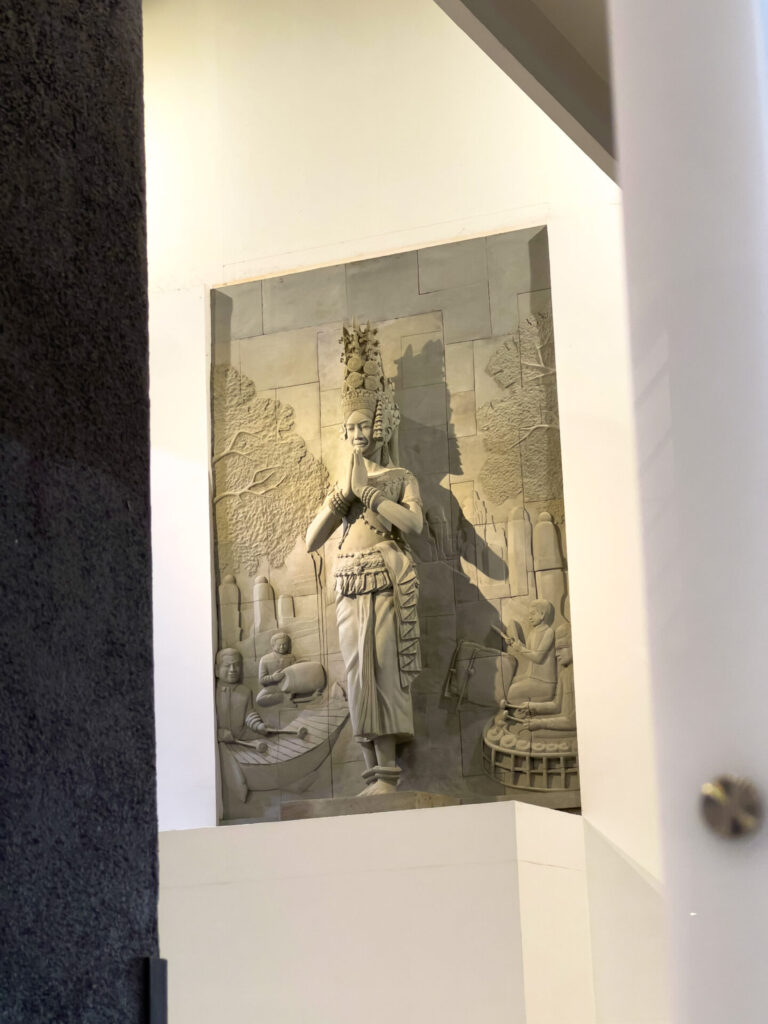
The visa process, thankfully, was relatively painless, a mere 30-minute ordeal. Love, with her ASEAN passport, breezed through visa-free, leaving me to contemplate the intricacies of international travel. We exchanged some US dollars, keeping a stash of those crisp $1 bills for souvenir hunting and shopping in Pub Street.
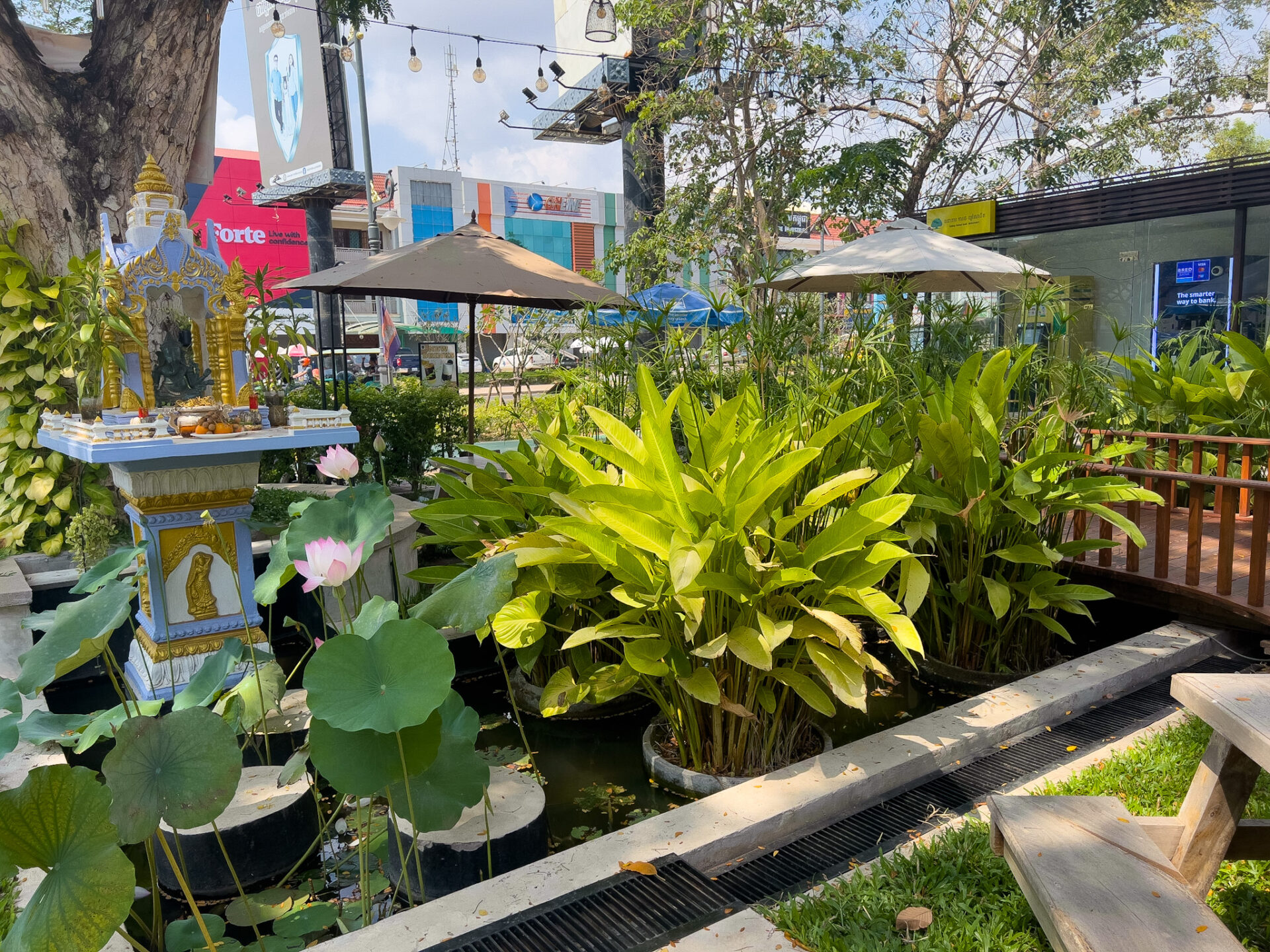
First Impressions of Siem Reap
Stepping out of the airport, we were immediately greeted by the warmth of Khmer hospitality. A friendly tuk-tuk driver welcomed us to Cambodia and offered us a ride to our accommodation. He helped us load our luggage, and we hopped into his vehicle, ready to get to our hotel.
The journey into Siem Reap was an experience in itself. On the way there provincial vibes washed over us: children playing in dusty yards, chickens pecking at the roadside, and the familiar, earthy scent of burning bush, a smell that took me back to my days in Belize. The air was thick with an exotic mystique, I observed small shrines at many residences, perhaps with offerings to ancestors. Downtown Siem Reap, strikingly clean and well-maintained, revealed an interesting blend of French colonial, Chinese, and Khmer architecture, a sign of the region’s rich and layered history.
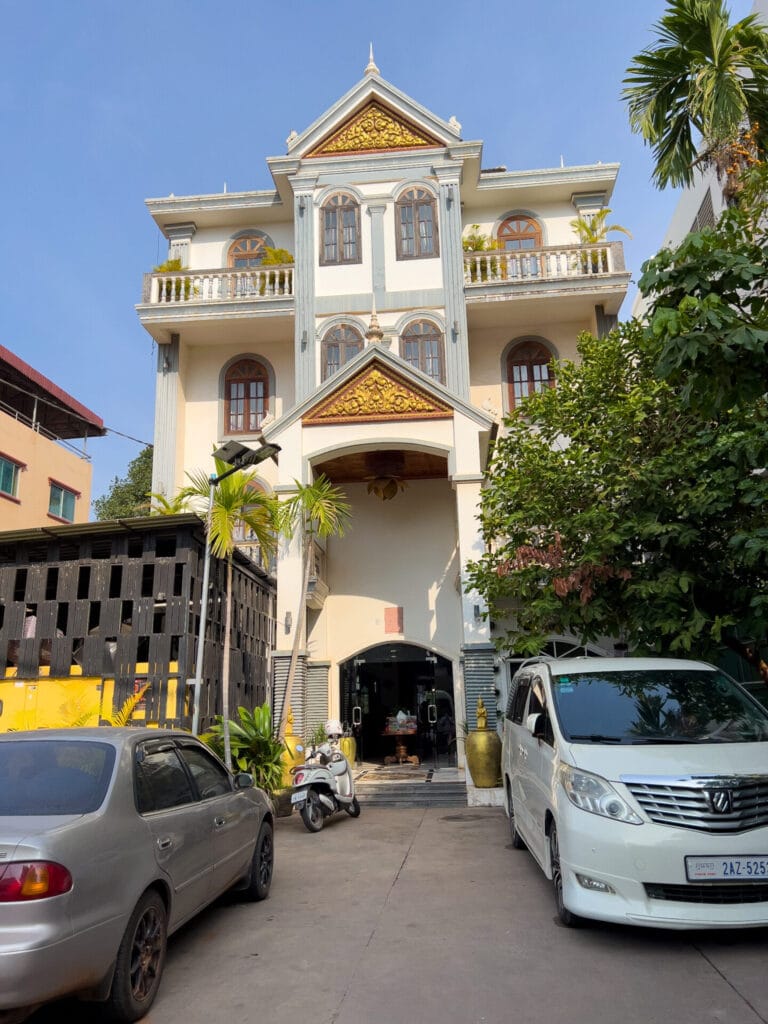
Our initial accommodation, the DV Angkor Villa, fell short of its Airbnb promises. While the local art and crafts were visually interesting, they couldn’t mask the underwhelming reality: a small room, weak air conditioning, and a general lack of comfort. It was clear we needed an upgrade. Thankfully, the Parent Heritage Angkor Villa proved to be a breath of fresh air for a mere $20 dollars per night. The spacious room, noticeably superior quality, and luxurious bathroom were a welcome change. The private balcony was a nice place to unwind, and the complimentary breakfast – an adequate spread of perfectly fried eggs, fresh tomatoes seasoned with kampot pepper, and crispy bacon – sealed the deal.
Visiting A Floating Village in Tonle Sap Lake
Before we stood in the shadows of Angkor Wat, we sought a deeper understanding of Cambodia’s countryside. A tour to the “floating village” on Tonle Sap Lake, booked through Klook (here is the link if you’re interested: https://www.klook.com/en-PH/activity/6473-kompong-phluk-floating-village-siem-reap/?spm=SearchResult.SearchResult_LIST&clickId=6cdfe62519) , promised a raw and authentic glimpse into rural life. For me travel is more than just sightseeing, it’s about witnessing the ingenious ways different cultures adapt to their environments.
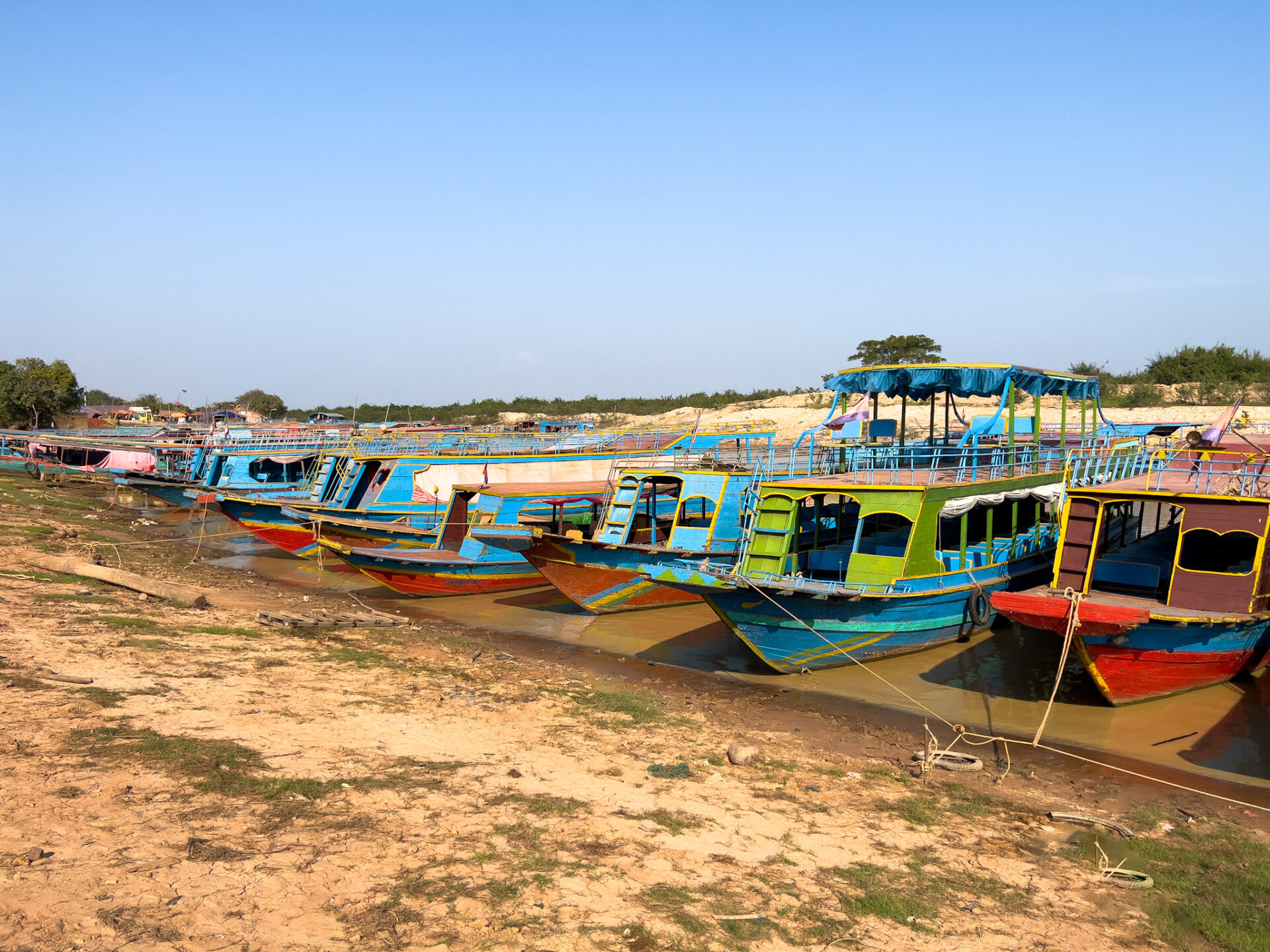
Our journey began with a bus ride from Siem Reap to a rustic riverbank, where a fleet of vibrantly colored boats awaited us. Each boat, sported makeshift Hyundai steering wheels, salvaged from discarded vehicles. It was a perfect example of resourcefulness, a quality that is a recurring theme throughout Southeast Asia.
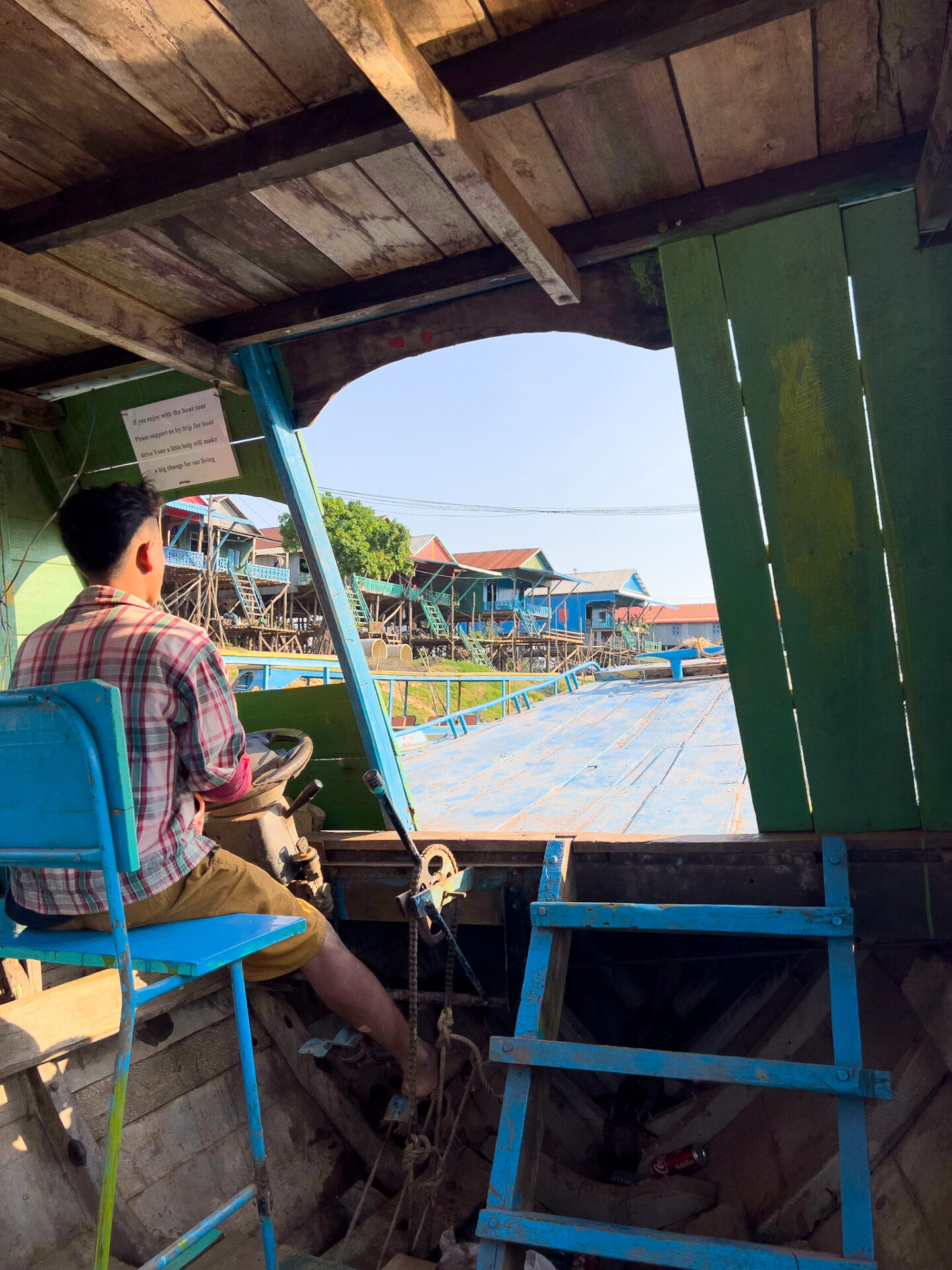
As we departed onto the murky waters of Tonle Sap, the reason for the village’s name became strikingly clear. Houses, perched precariously on towering wooden stilts, some reaching a staggering 26-33 feet (8-10 meters) above the water, lined the riverbanks. These remarkable structures, we learned, were a vital adaptation to the lake’s seasonal floods, which transform the landscape during the rainy season.

We watched as villagers went about their daily routines, casting and retrieving fishing nets in the muddy waters, a timeless ritual passed down through generations. Their ancestors, the Khmer, the very builders of Angkor Wat, were renowned for their mastery of water management, a legacy that continues to shape life on Tonle Sap. This experience was about to give me a greater understanding of the people that built the incredible structures we were about to visit in Angkor Wat.

A Walk Through Kampong Phluk Village
Our boat eventually docked at Kampong Phluk, the ‘floating village’. Loud, festive music, a distinctively Indochinese blend of Indian and East Asian melodies, echoed through the air. We soon discovered the source: a wedding, a special occasion that filled the village with life and energy.
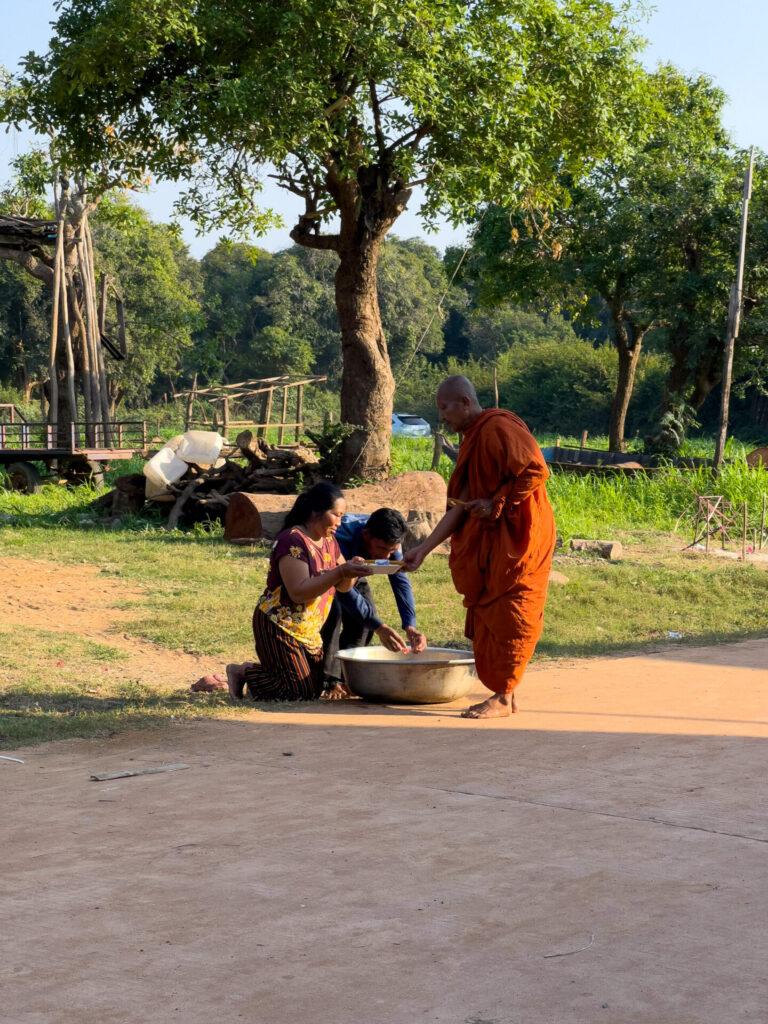
Walking through Kampong Phluk felt like stepping into another world. The air was thick with the smoky aroma of freshwater fish being cured, a unique scent that mingled with the sounds of Khmer music and laughter. Buddhist monks, their saffron robes a splash of color against the rustic backdrop, moved through the village, blessing residents with holy water, thought to bring good luck and happiness. They were accompanied by villagers dressed in traditional Khmer attire, some carrying elaborately carved wooden serpent staffs, adding an element of ancient ritual to the scene.
Buddhist architectural elements, miniature stupas and intricate carvings, dotted the landscape, reminders of the deep spiritual roots of the community. The earth itself seemed to pulse with life, a deep red hue indicative of the rich clay soil that sustained the village. Children, their laughter echoing through the narrow walkways, darted between houses, their energy as vibrant as the colors of the surrounding environment.
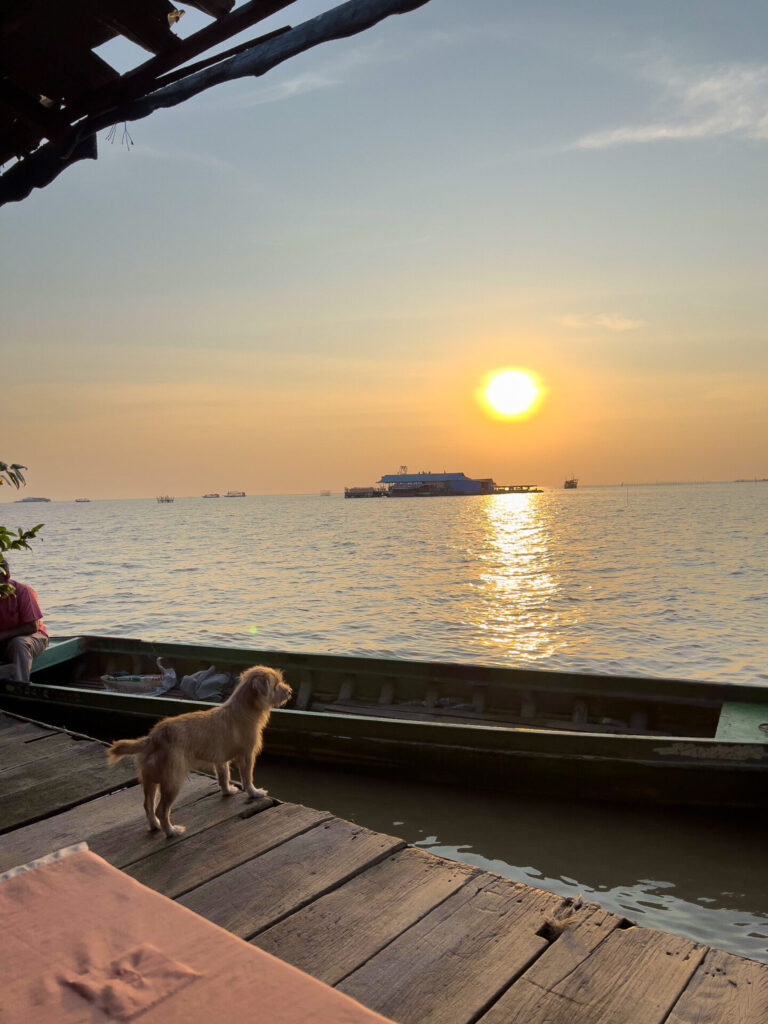
Enjoying A Sunset Dinner At The Floating Restaurant
After taking an unforgettable walk through Kampong Phluk, our journey continued with another boat ride to a “floating restaurant”. Kem Rib Tonle Sap Restaurant, as it is called, lived up to its name, bobbing gently in the middle of the large expanse of water.
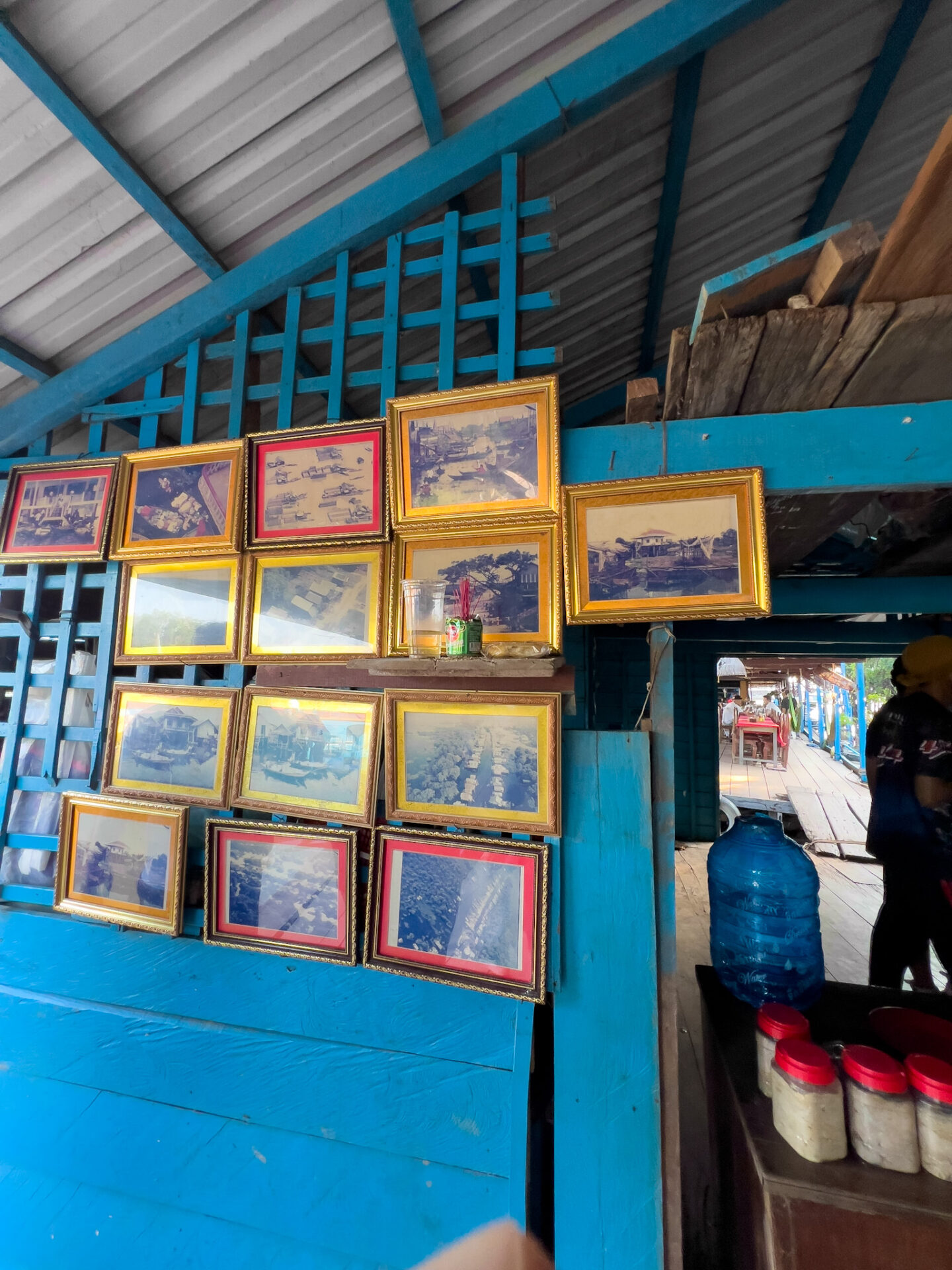
The restaurant’s decor was a vintage time capsule, adorned with photo frames that seemed plucked from the 70s or 80s, creating an interesting nostalgic ambiance. Hammocks swayed gently, inviting guests to relax and soak in the breathtaking sunset views. A crocodile farm on the premises added an almost unexpected surreal element to the restaurant.
Looking through the menu, I noticed a curious selection of snake, crocodile, and frog. Having never tried any form of amphibian dishes at the time, I couldn’t resist the opportunity. Accompanied by a refreshing Angkor beer, I ordered the fried frog.
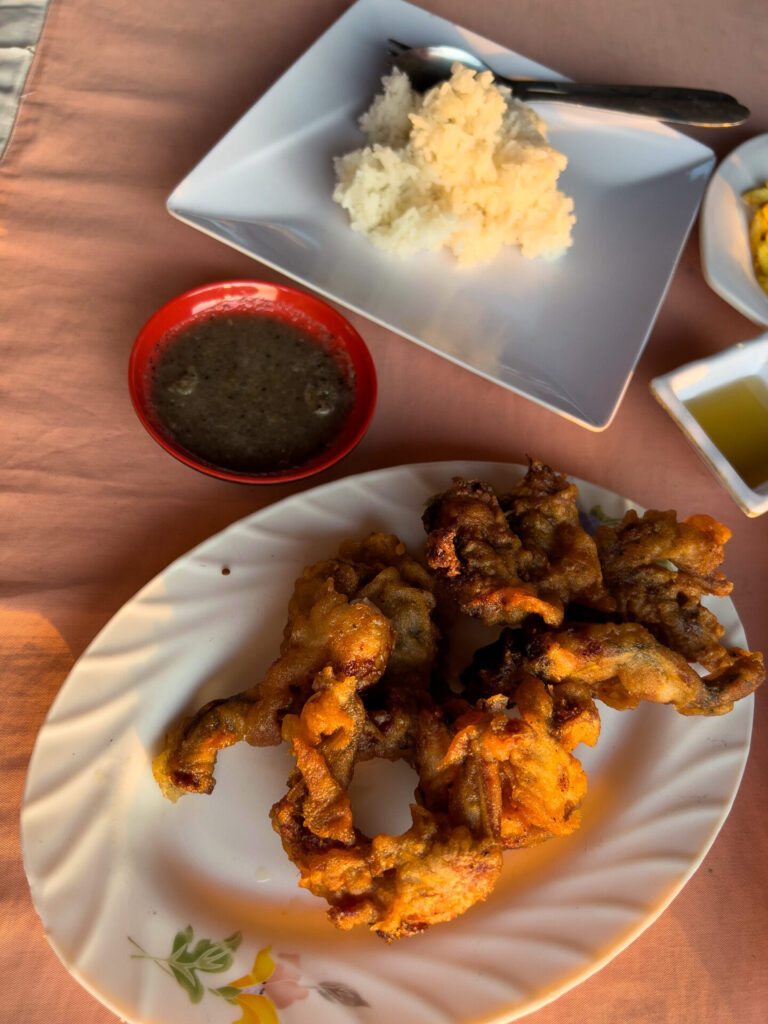
When it arrived, it came fried to a crispy, golden perfection. I know it’s cliché, but it tasted like chicken – tender, juicy, and surprisingly delicate. The freshness was there, as if the frog had been plucked straight from the lake’s shores moments before. It was served with a side of white rice and a pungent, fermented fish dipping sauce. My best guess is that it was a prahok-based sauce, a Cambodian staple made from fermented mudfish, adding a deeply savory and distinctly local flavor to the meal. The entire experience of having dinner on that floating restaurant, as the sun set over the lake, was unforgettably unique.
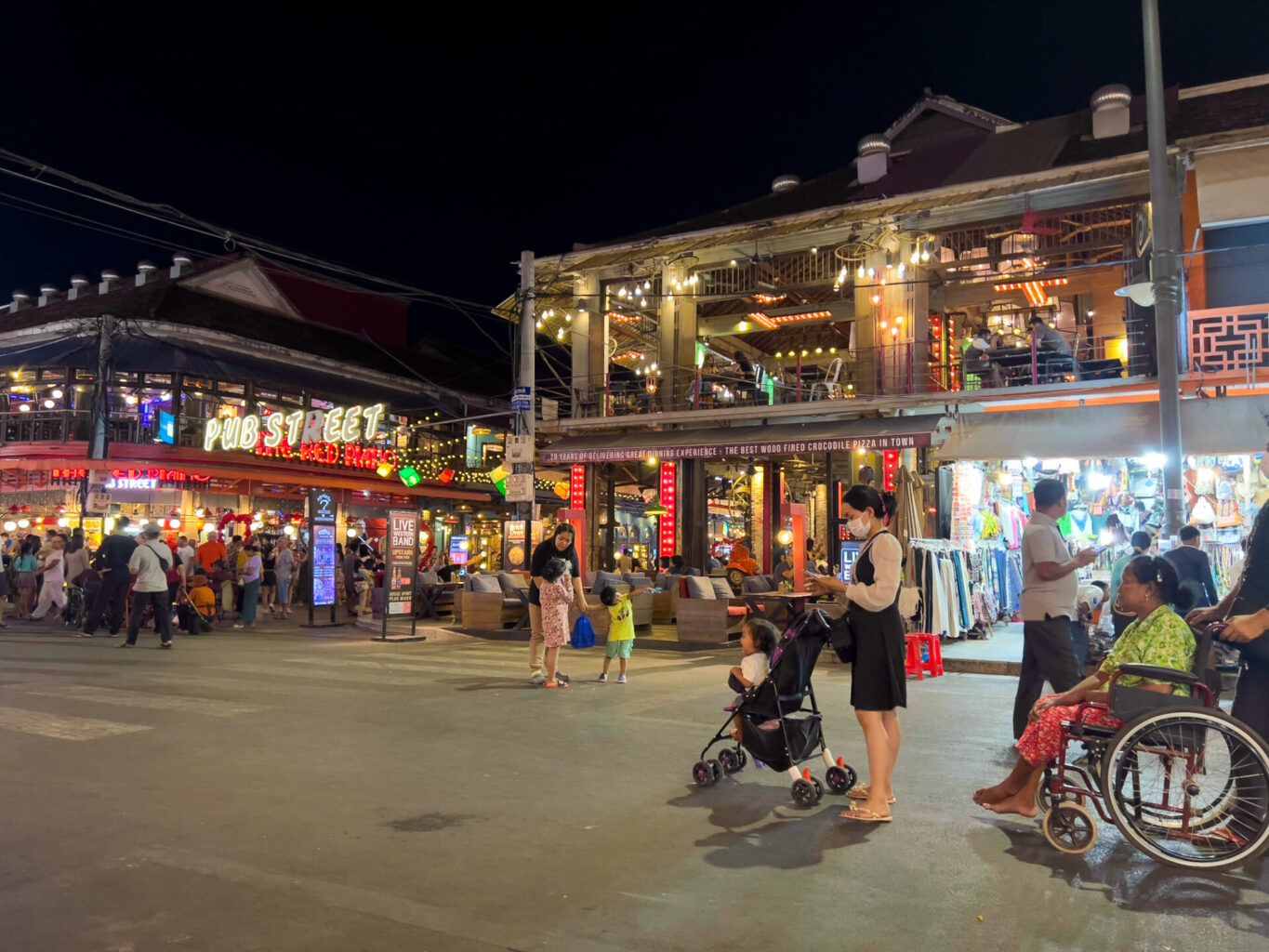
Experiencing Siem Reap’s Pub Street Scene
Later that night, we took a trip into the electric chaos of Pub Street, Siem Reap’s answer to Khao San Road, if Khao San grew up a little, mellowed out with age, but still knew how to throw a party. The scene was very lively with an eclectic mix of locals, backpackers, and tuk-tuk drivers. Neon signs lit up the night like a casino in the jungle. Bars, restaurants, street vendors, and souvenir shops jostled for attention, but no one seemed in a hurry.
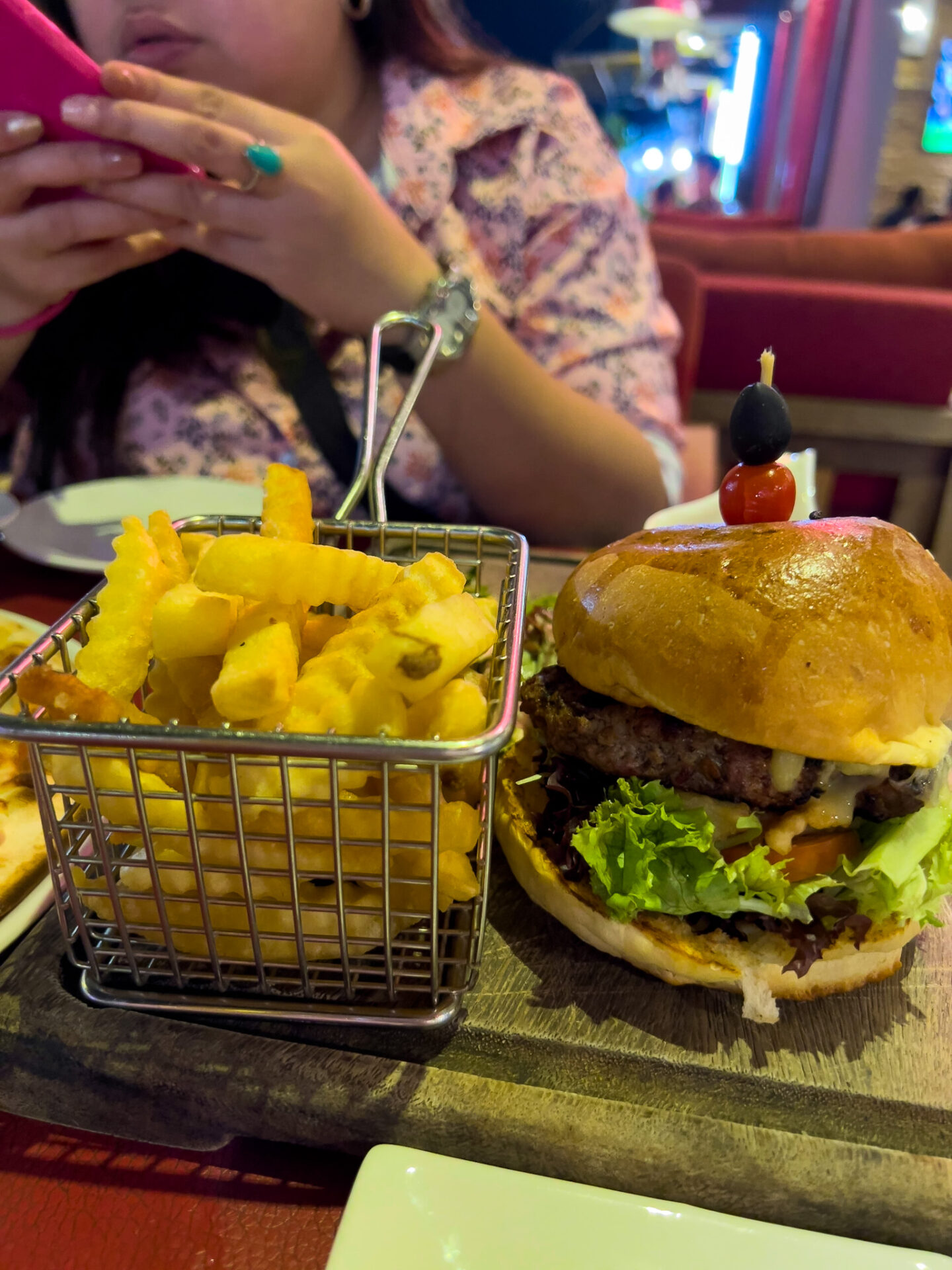
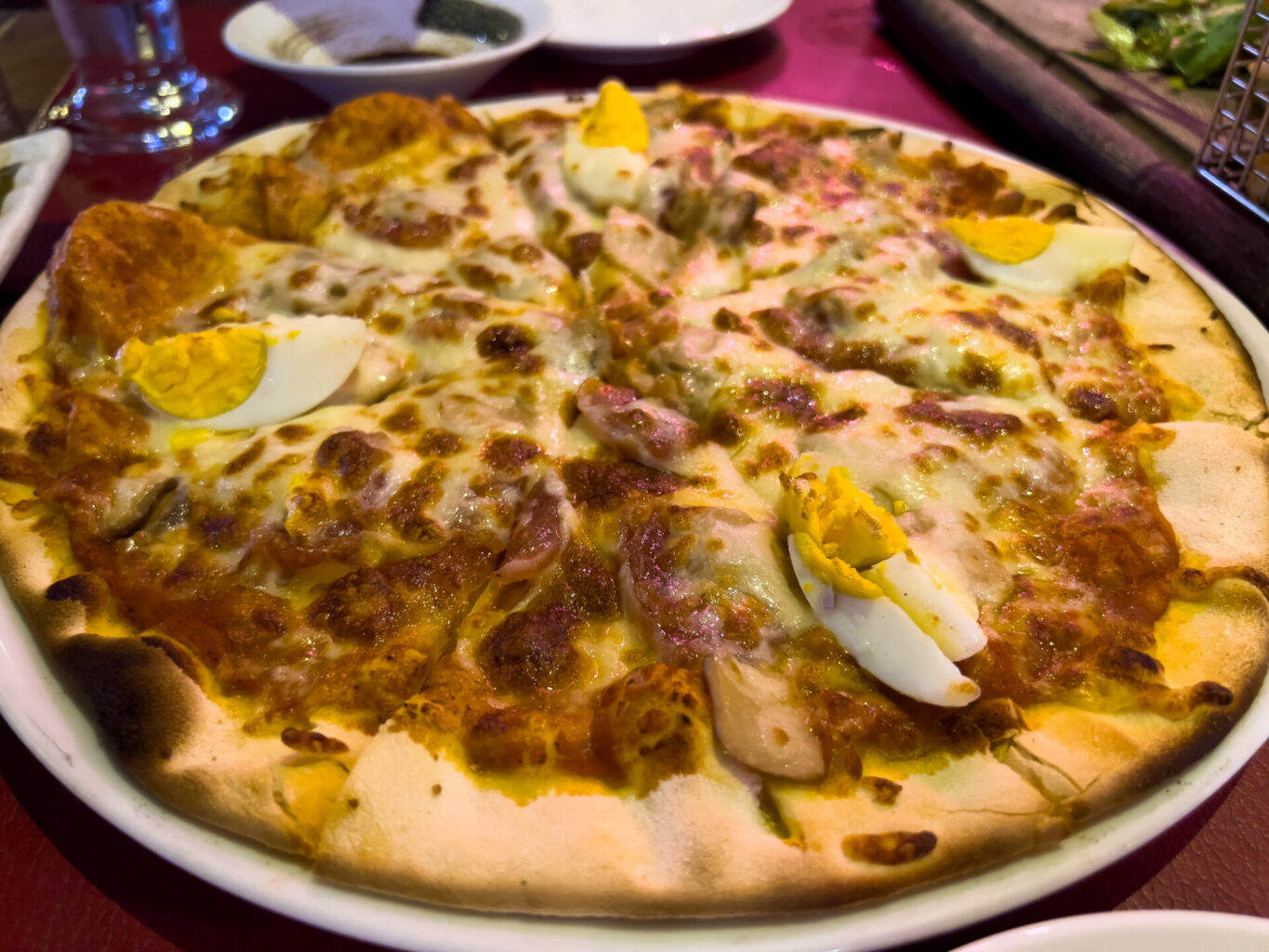
We decided to try out Temple Design Restaurant, lured by the warm lighting and the scent of grilled meat wafting out the door. And to our surprise? The food hit the spot. A Cambodian egg and pork sausage pizza with a crispy crust showed up alongside a greasy cheeseburger that hit all the right notes after a long travel day. I washed it all down with a couple cold draft beers. The prices? Let’s just say we paid Bangkok street food money for a sit-down experience—and noticed crocodile dishes peppered across the menu for the bold.
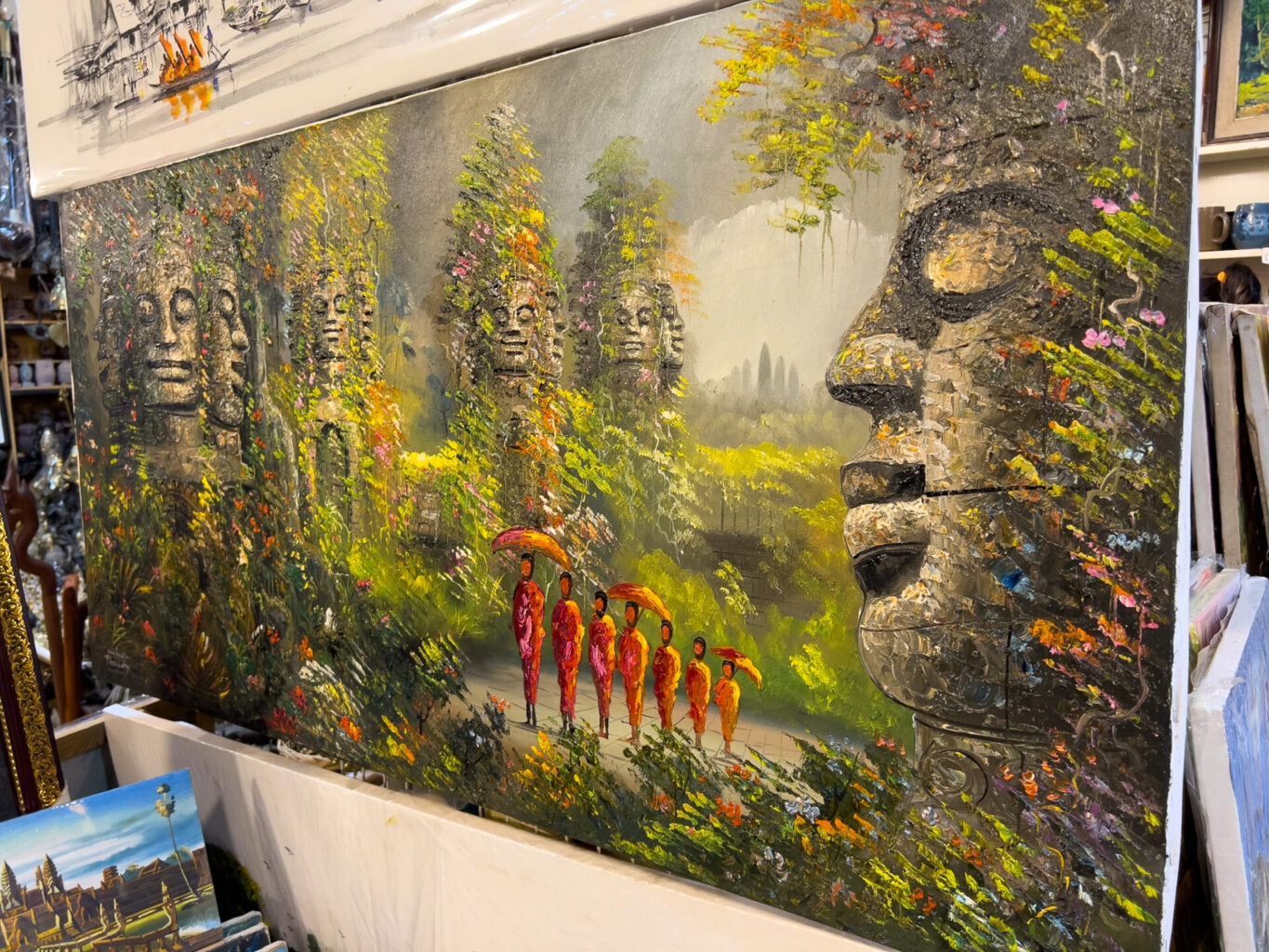
Afterward, we wandered down Street 11 and stumbled into a souvenir shop that was far more than tourist bait. Among the silk scarves and fridge magnets were good quality hand-painted Khmer artworks—intricate, detailed, and emanating with character. I couldn’t resist. I grabbed a few to bring home, unframed and raw, like stories waiting to be told. Then came the Kampot peppercorns—Cambodia’s black gold. I’d read about them, but nothing prepared me for their sharp floral aroma, their peppery bite, and just how much flavor could be packed into something so small. A few bags into the backpack, alongside some silk pieces, and we called it a night.

The Enigmatic Angkor Wat
Angkor Wat. There’s no way to overhype it—it’s the kind of place that silences you.

The next morning, we set off to see what was undoubtedly the main event of our trip to Siem Reap. I’d seen the pictures, watched the documentaries, read the blurbs in travel guides. But nothing prepares you for the scale of Angkor Wat. Nothing.
More than 50 temples sprawled across a jungle-draped landscape—it’s not just a single monument, but a city of stone, an ancient city carved into time. I’d been to my fair share of Maya ruins back when I lived in Belize—Xunantunich, Altun Ha, Lamanai—but this? This was something else entirely. Angkor Wat is immense, around the size of London they say.
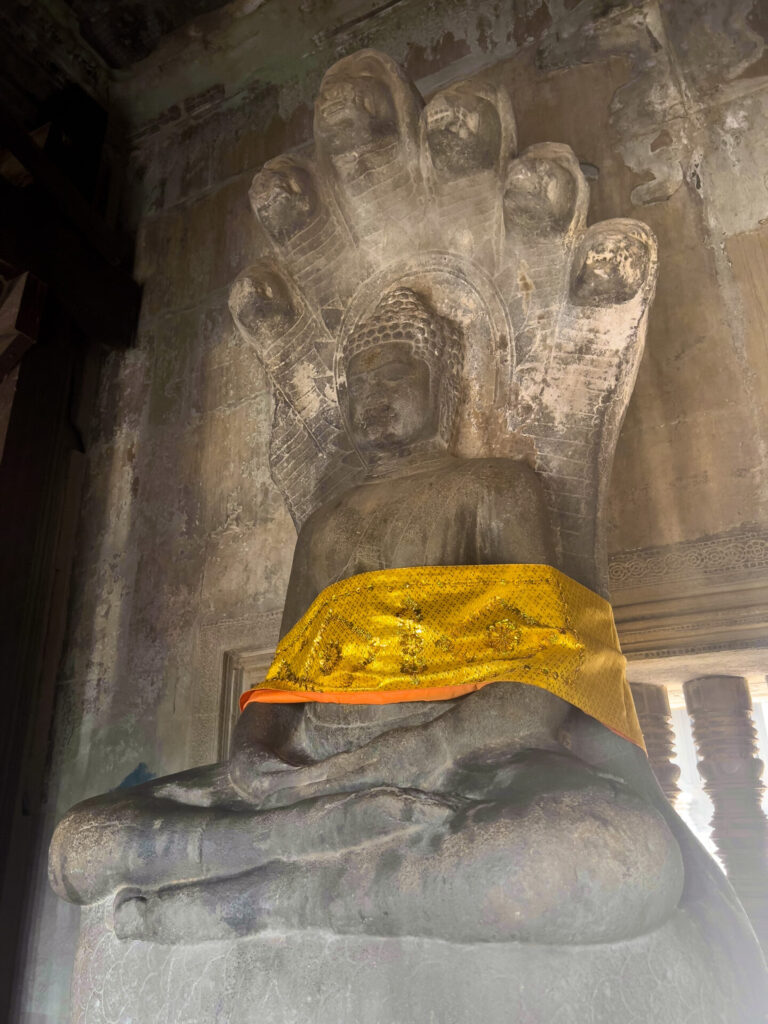
Originally constructed in the early 12th century and “rediscovered” in 1860 by a French naturalist near Tonlé Sap Lake, Angkor Wat has always carried an air of enigma. Locals at the time weren’t even sure who had built it. There’s something poetic about that—a civilization so grand it vanishes into the forest, only to emerge centuries later with vines crawling over its ruins and stories still etched into its walls.
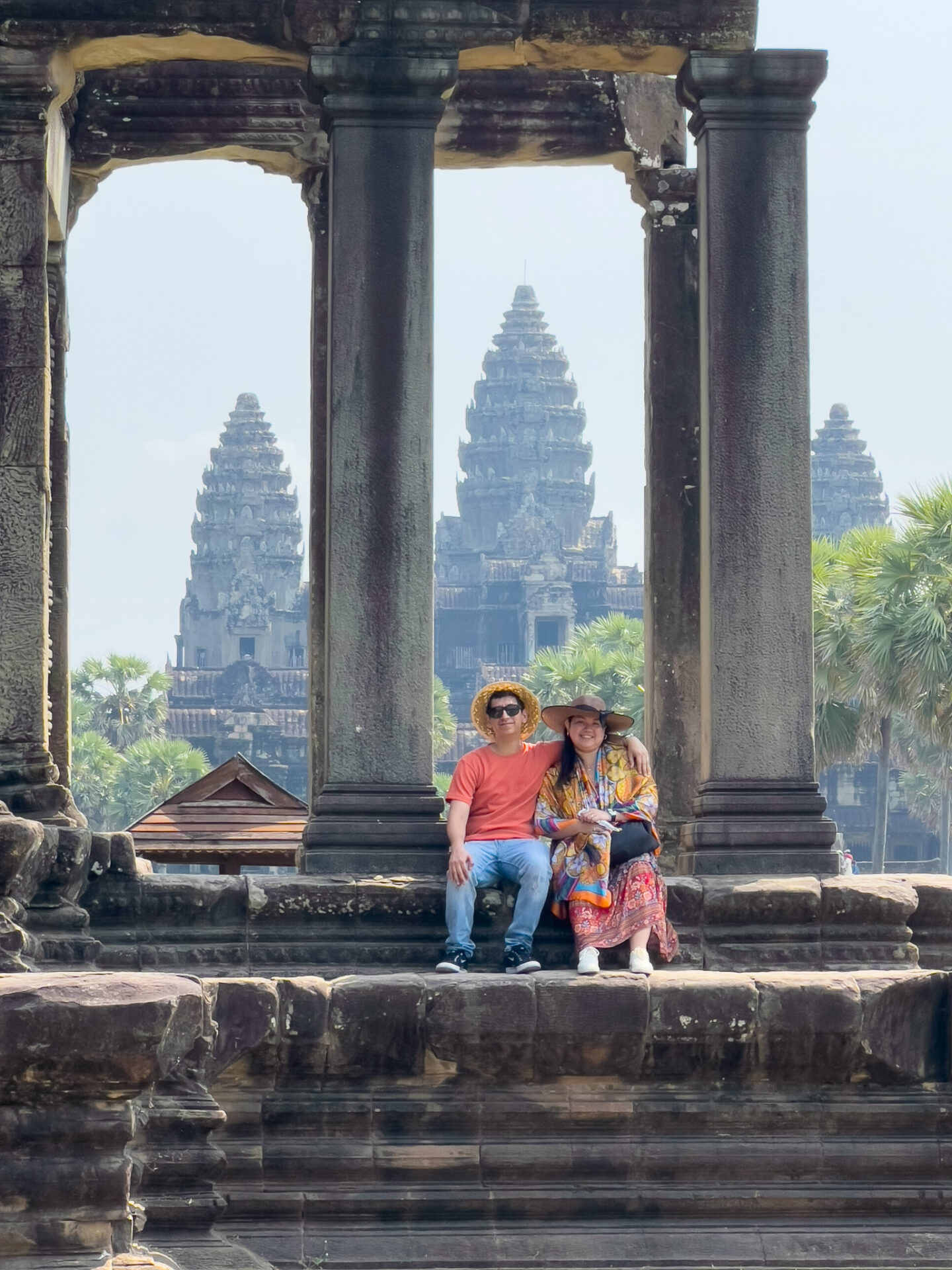
The corridors stretch on and on, with intricate bas-reliefs that might just be the largest in the world—scenes from Hindu epics, celestial dancers, battles frozen in sandstone. The iconic towers are shaped like lotus flowers, perfectly symmetrical, a divine geometry that made me stop in my tracks more than once just to take it all in. Standing there, amidst the ancient stones, you can’t help but feel a profound connection to a civilization that possessed such incredible vision and engineering prowess.
By the end of our day, Love and I were beyond exhausted. This place doesn’t just ask you to look. It demands your energy, your attention, your awe. If I could do it again? I’d spread it out over two or three days—soak it in slowly instead of sprinting through it like we did.
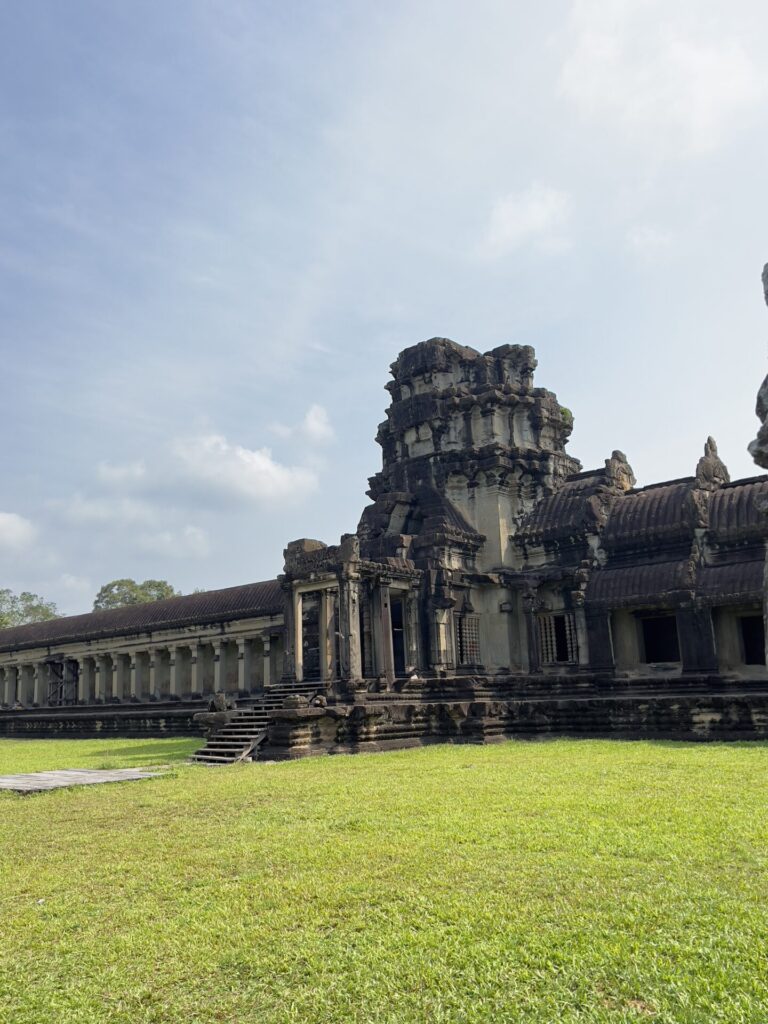
First Impressions of Angkor Wat
We booked a guided tour through Klook (Link to that here), an easy, hassle-free way to make sure we made the most of our short time in Angkor Wat, complete with a tour that picks you up at your hotel in Siem Reap. A single-day pass to the Angkor Archaeological Park cost us $37 each (Link here if you’re interested in buying them online: https://www.angkorenterprise.gov.kh/) , a small price to pay for the majesty that awaited us.
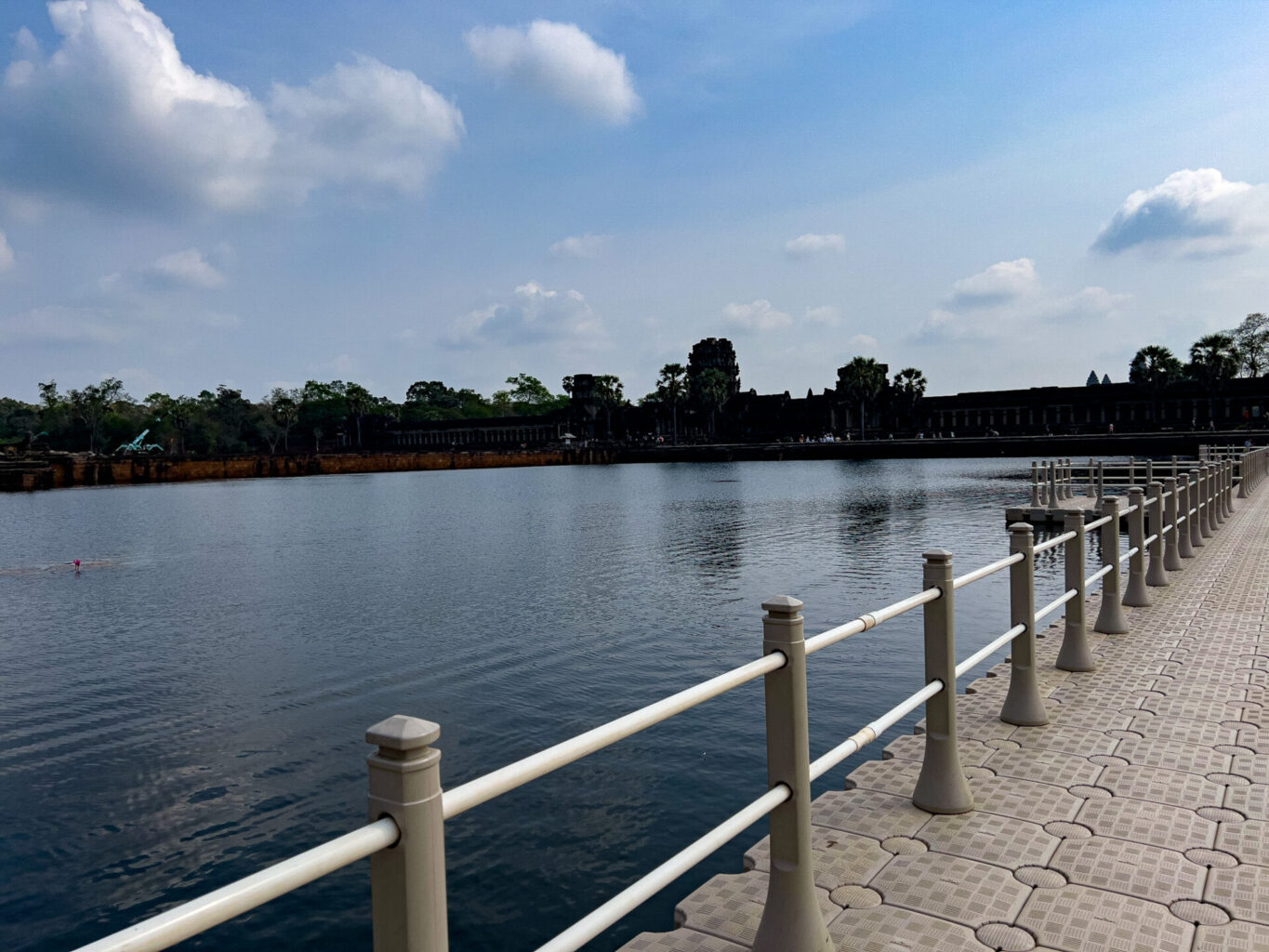
Angkor Wat’s Massive Moat: A Cosmic Welcome
The moment we arrived, Angkor Wat greeted us not with towering spires, but water—a massive moat that wrapped around the temple like a protective embrace. I later learned that the moat symbolizes the cosmic ocean that surrounds Mount Meru, the mythical home of the Hindu gods. Before Buddhism became dominant in Cambodia, the Khmer Empire practiced Hinduism, and the architectural symbolism runs deep throughout the complex.
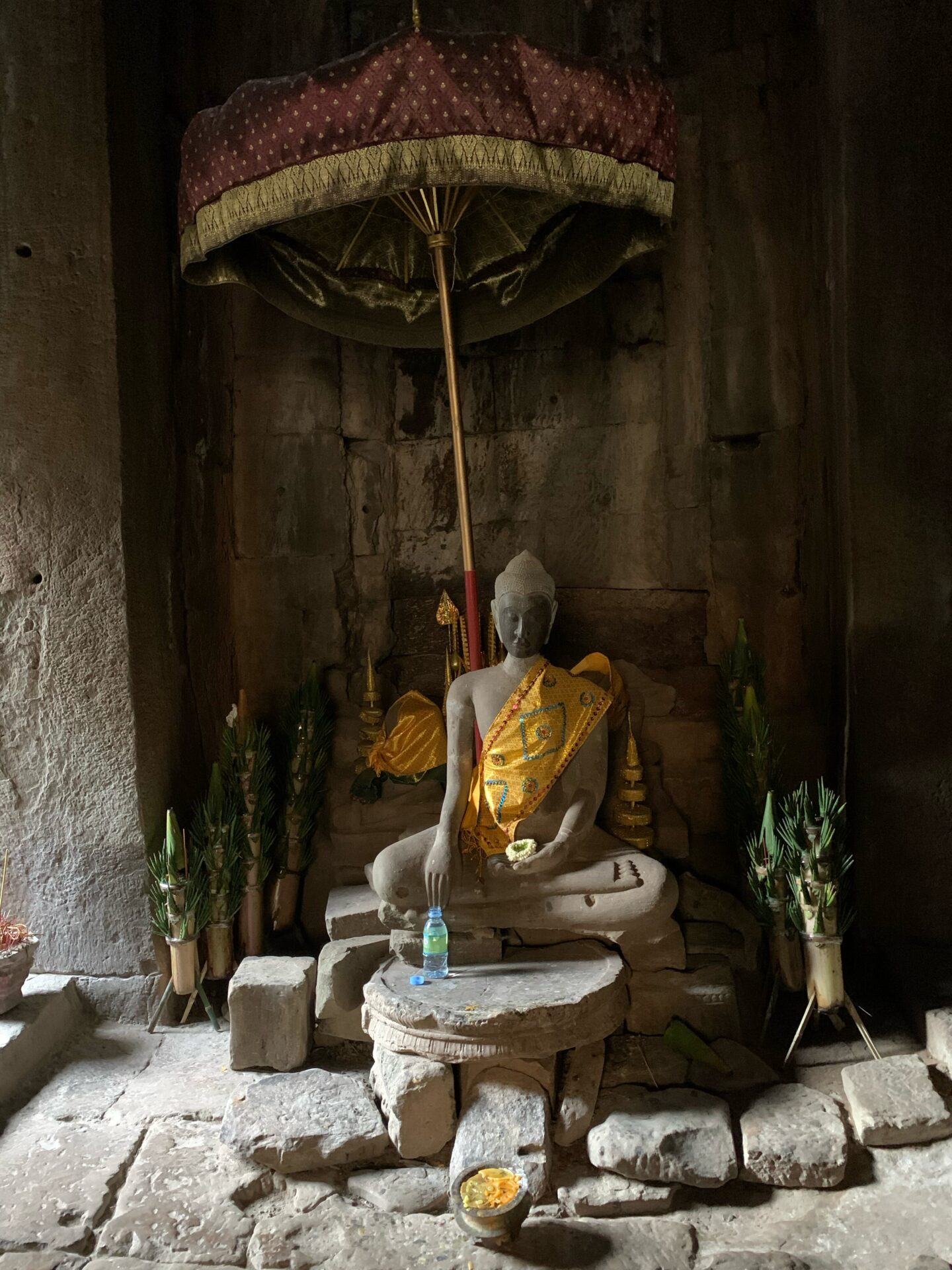
As we crossed the long stone causeway into the temple grounds, the weight of history became tangible. The heat was unrelenting—thick, heavy, jungle heat—but it added a layer of primal atmosphere to the experience. This was a living, breathing relic, draped in humidity and still very much alive.
Stone Stories: The Bas-Reliefs of Angkor Wat
Inside the temple, I was floored by the bas-reliefs—endless galleries of intricate carvings, each one more detailed than the last. Some depicted epic battles, others divine processions. They were stories etched in stone, stories that took decades—decades—to complete. The sheer patience and vision of the Khmer artisans is something I still can’t wrap my head around.
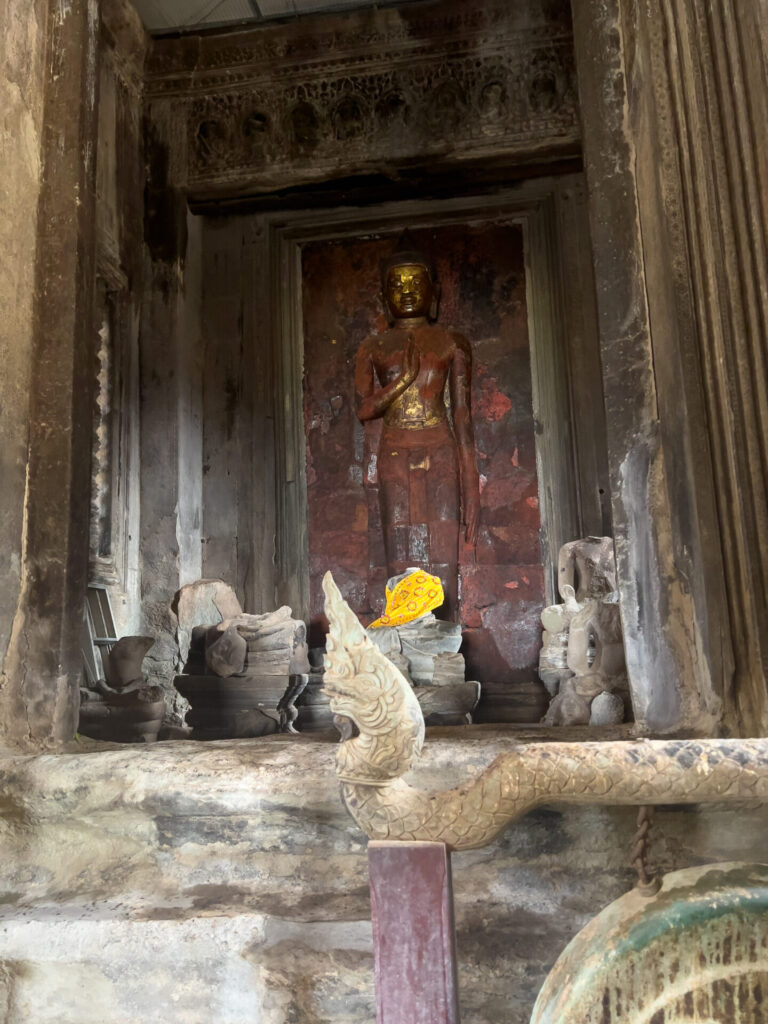
Buddhas in the Shadows
As we wandered deeper, Buddhas began to appear in corners and alcoves, tucked between columns, perched in shrines. Some were headless—whether lost to time, looters, or political turmoil, I can’t say. But the absence of their heads somehow made them even more haunting. More sacred, in a strange way.
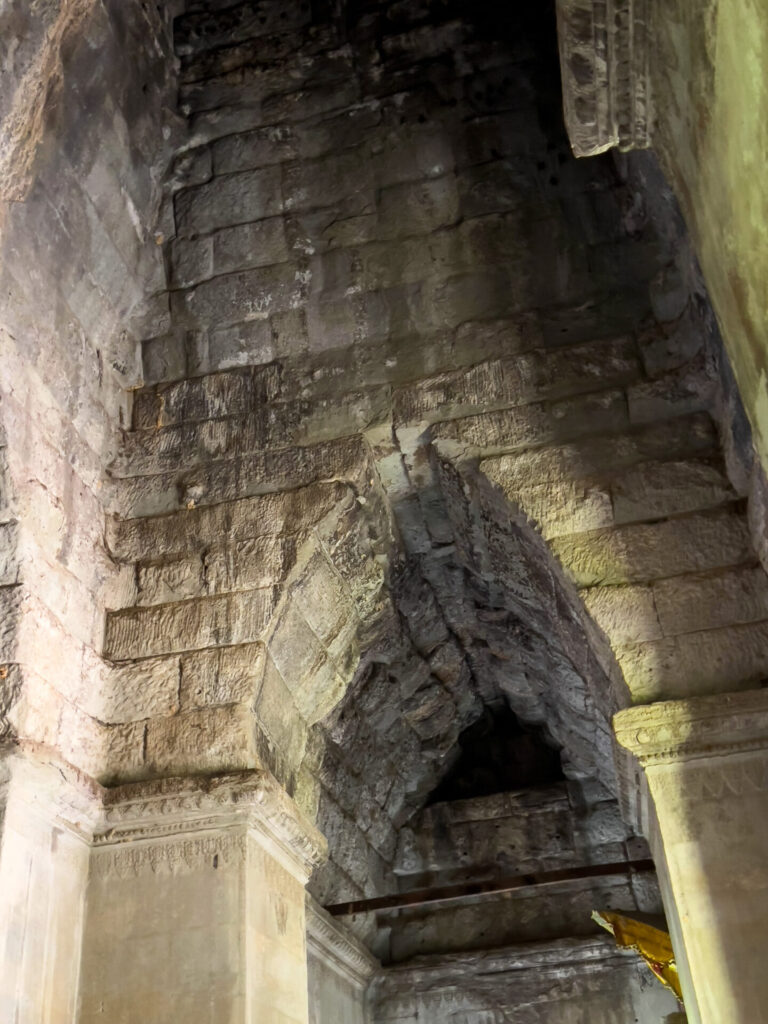
Ancient Echoes: The Corbel Vaulted Doorways
One moment that genuinely stopped me was when I looked up and noticed the corbel-vaulted doorways—stone stacked in a way that narrowed overhead until they formed a passage. They were nearly identical to the ones I’d seen at Maya ruins in Belize. Same engineering. Same solution. Entirely different civilizations.
It’s things like that that remind you that we may be separated by oceans, culture, and language, but at the core, humans have always been creative problem-solvers, builders, dreamers. Somehow, two ancient civilizations, one in Southeast Asia and one in Mesoamerica arrived at the same idea. That’s not coincidence—it’s convergence. And it’s beautiful.
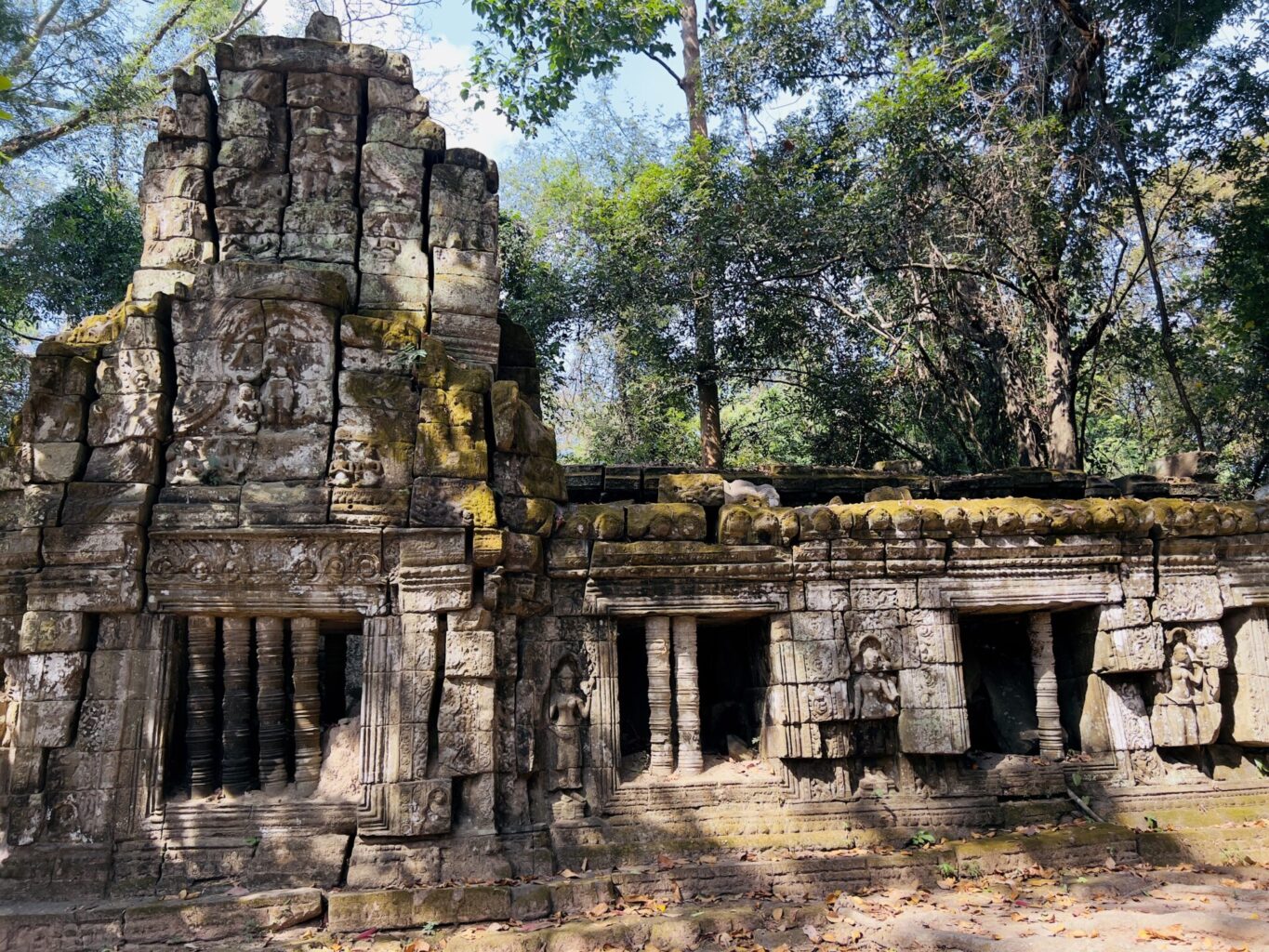
Wandering Through Angkor Thom
The path from Angkor Wat to Angkor Thom felt like walking through time itself.
We took a jungle trail instead of the main road, and the experience was nothing short of surreal. Towering trees filtered the sunlight into golden shafts, and in the distance, the enchanting sound of live Khmer music floated through the air. A few locals were dancing—graceful, slow movements that seemed to echo centuries of tradition. The vibe? Exotic. Mysterious.
Just a couple of kilometers away from Angkor Wat, we reached Angkor Thom—the final and grandest capital of the Khmer Empire. Unlike the spiritual solitude of Angkor Wat, Angkor Thom felt imperial. Majestic. This was a fortified city, a masterpiece of urban planning with wide avenues, monumental gates, vast reservoirs, and a layout so deliberate it made modern cities seem like chaotic afterthoughts.

At its heart lies Bayon Temple—my personal highlight of the entire complex.
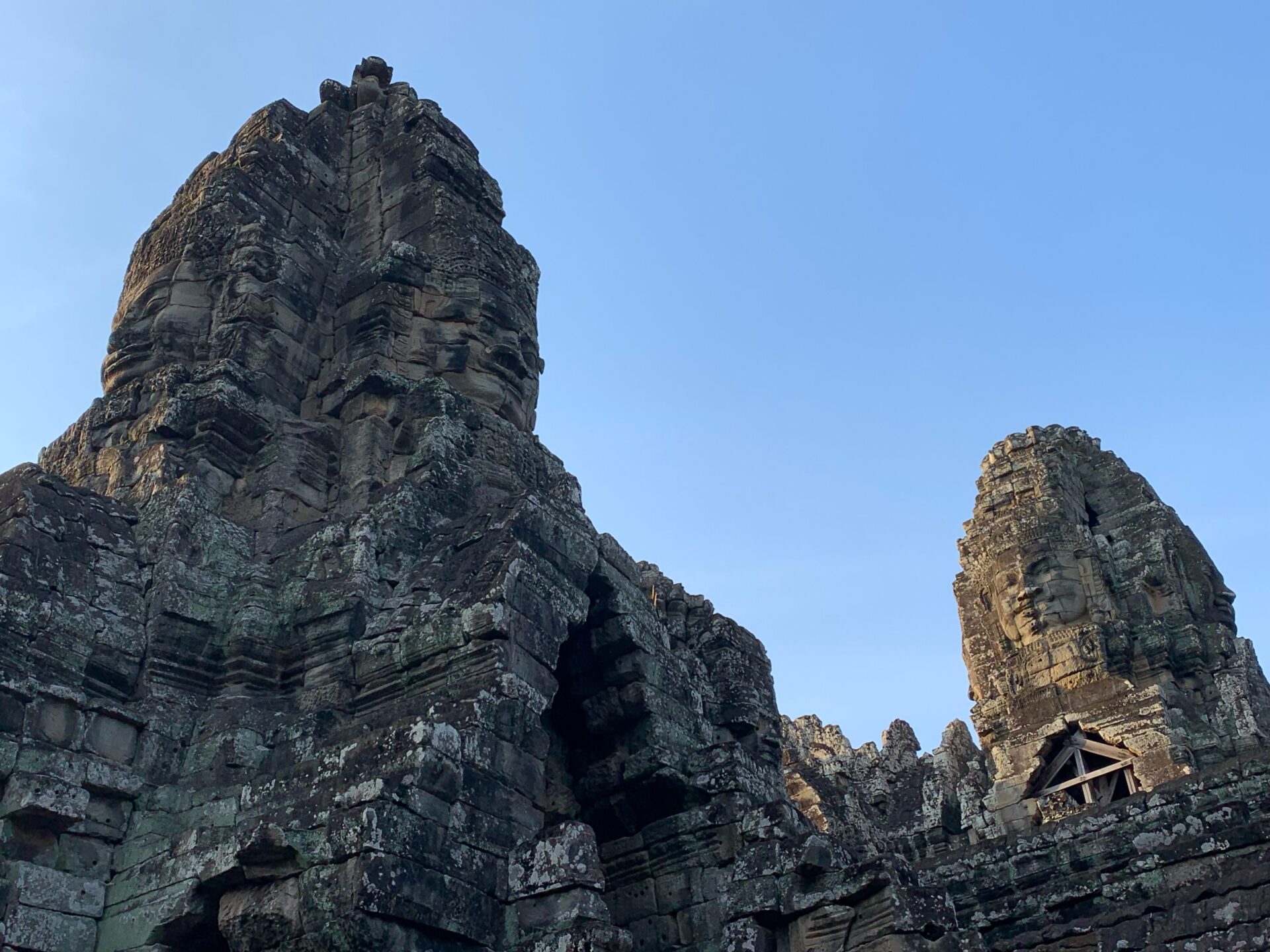
Nothing quite prepares you for the stone faces. Dozens of them, carved into towering spires, each bearing the same serene, enigmatic smile. Some say they represent King Jayavarman VII, others believe they are images of the Bodhisattva Avalokiteshvara. Either way, those faces aren’t just watching over the temple—they’re watching you. It’s eerie in the most beautiful way.
Again, my mind drifted to the Maya ruins back in Belize. The resemblance wasn’t in the aesthetic—Khmer art is unmistakably its own—but in the spirit of the architecture. The monumental scale. The devotion carved into every stone. The way the past still echoes in these places. Civilizations half a world apart, building in stone, dreaming in myth, and leaving behind silent cities that still speak if you’re willing to listen.
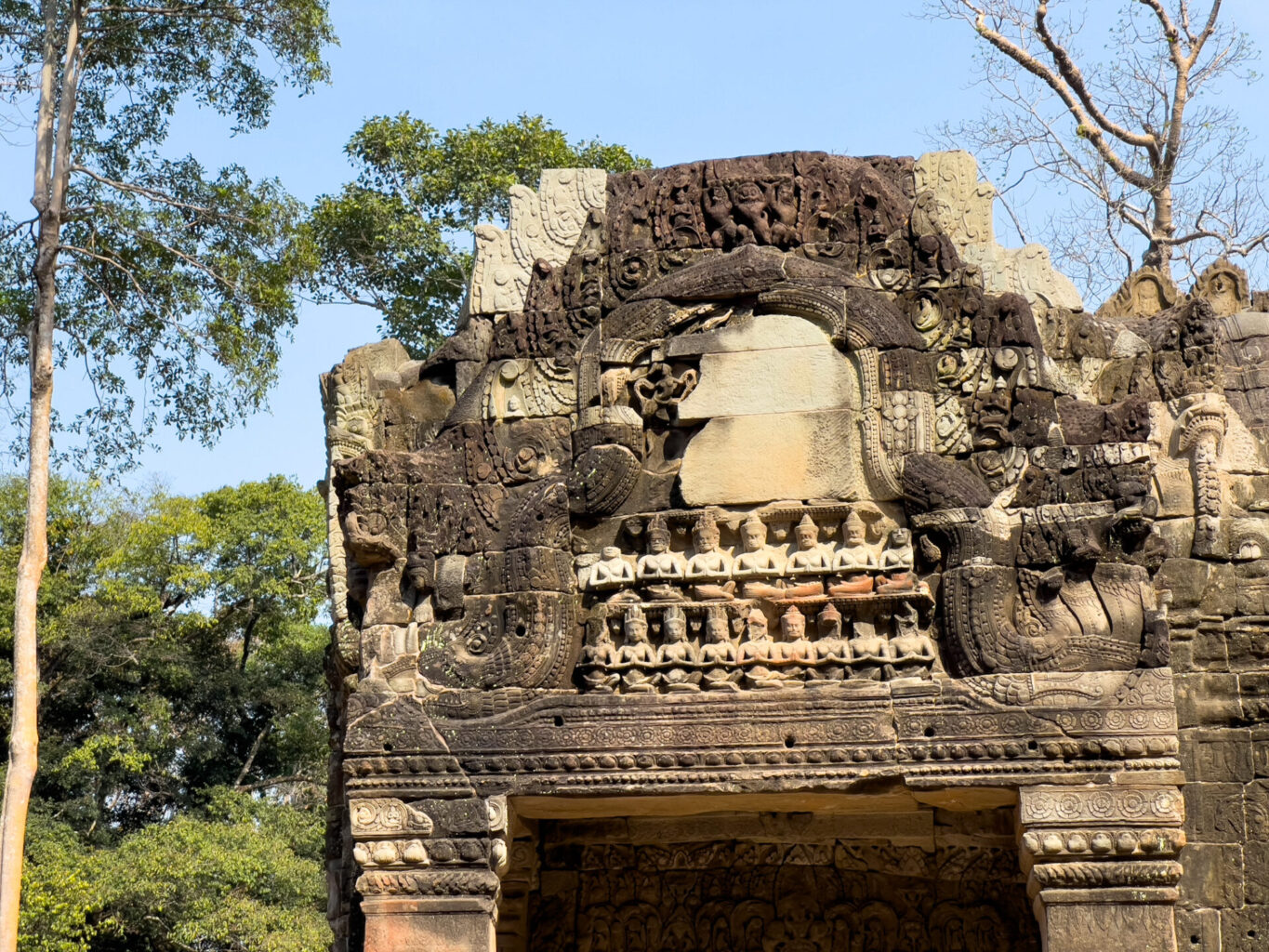
Ta Prohm – Where the Jungle Breathes
If Angkor Wat is the heart and Angkor Thom the mind of the ancient Khmer Empire, then Ta Prohm is undoubtedly its soul.
This is the ruin that most people recognize, even if they don’t know it by name. Think Tomb Raider—yes, that enigmatic, vine-draped temple where nature and civilization collide. But no Hollywood scene could do justice to the feeling of actually being there.
A Temple Entwined with Time and Trees
Walking into Ta Prohm is like entering a temple that’s halfway between this world and another. Time stands still. Light filters through the thick jungle canopy in shafts of soft gold, illuminating stone corridors overtaken by thick roots of silk-cotton and strangler fig trees. These colossal roots don’t just cling to the ruins; they embrace them, as if the jungle is slowly pulling the temple back into the earth.
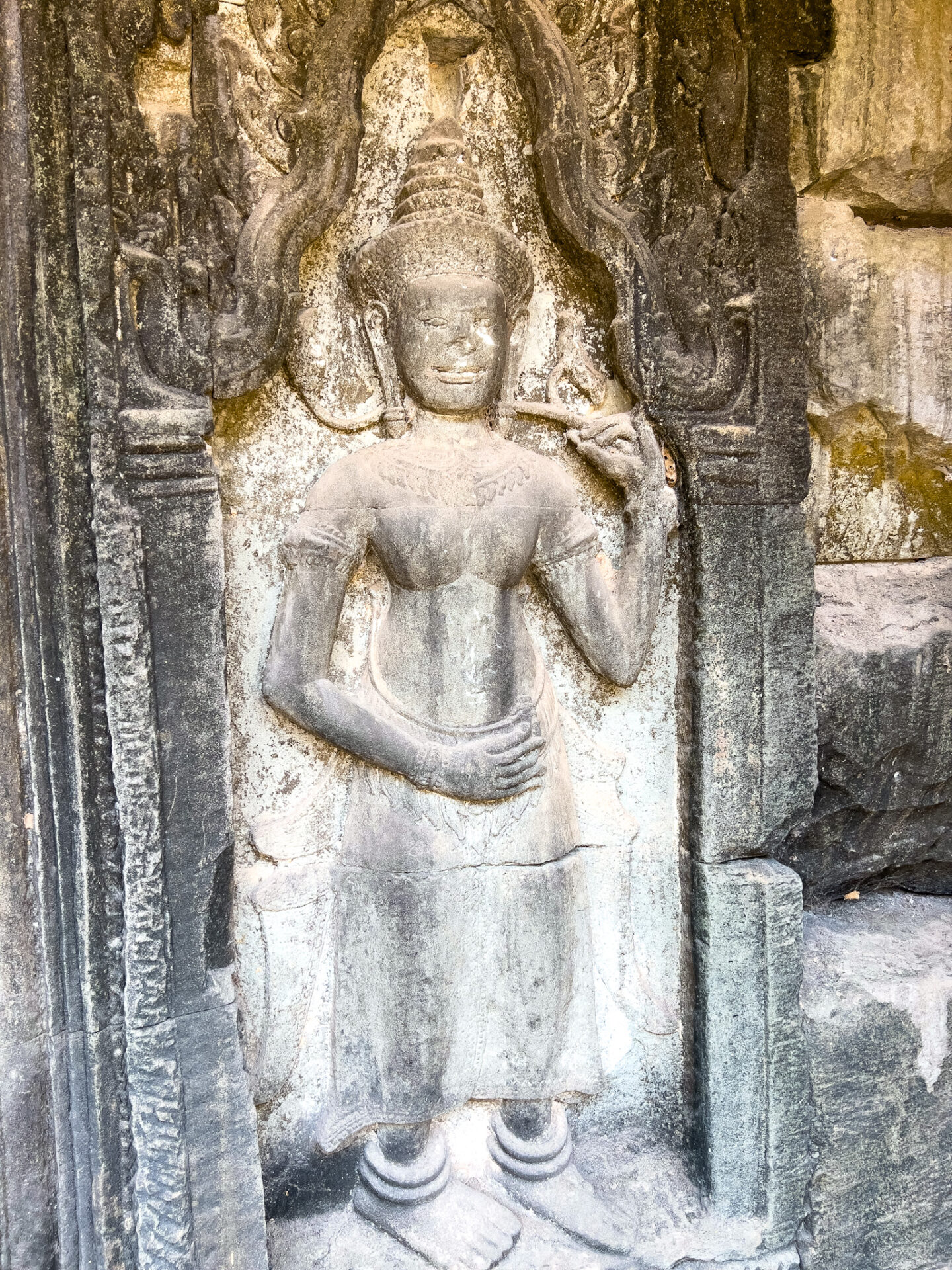
Whispers of the Ancient World
What once was a center of spiritual learning is now a stunning example of nature reclaiming man’s ambition. Moss and lichen coat every surface. The carved reliefs—still astoundingly intricate—peek through cracks and crevices as if whispering ancient truths through time-worn stone.
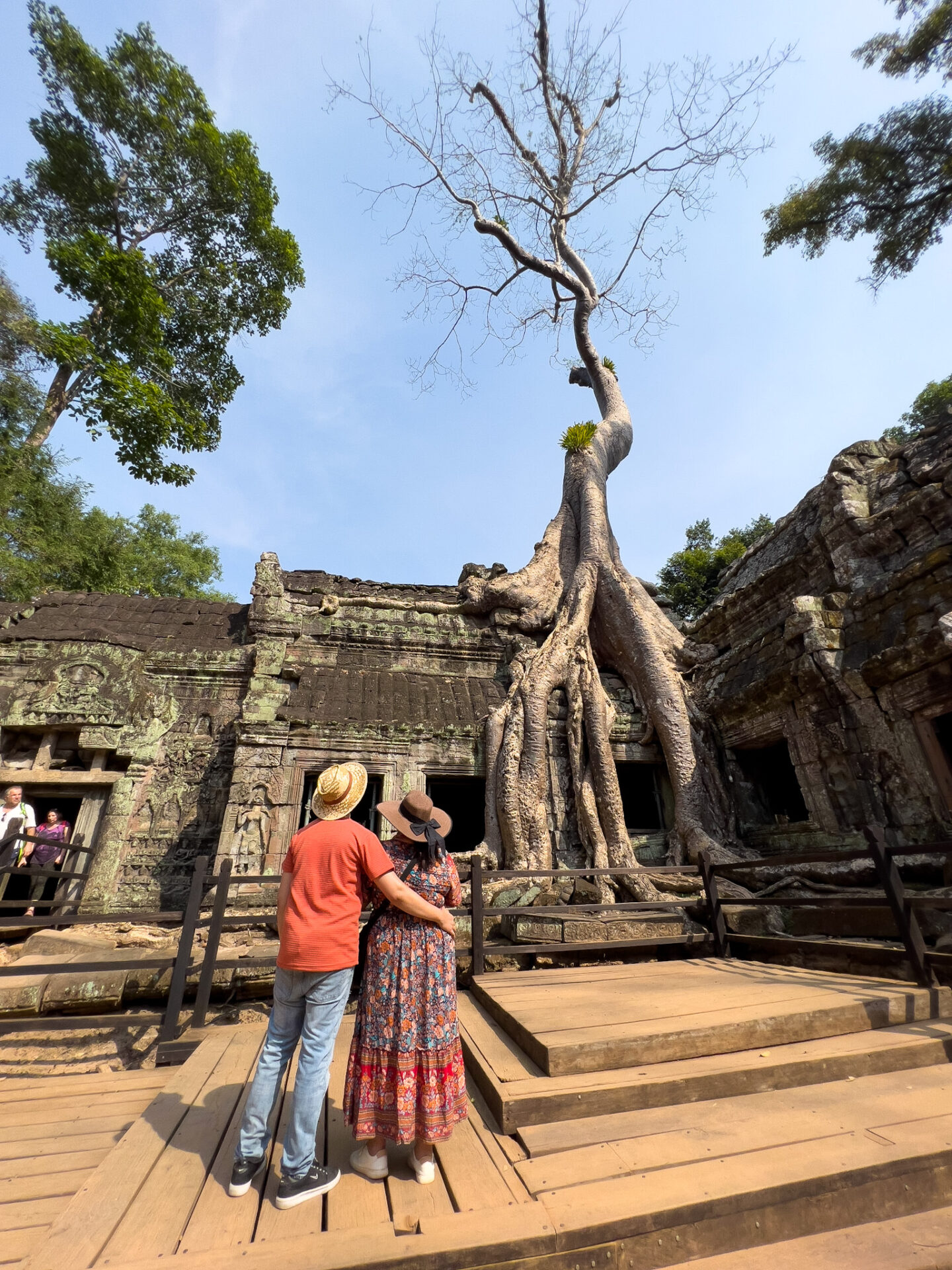
Wandering and Wondering
There’s something deeply spiritual about Ta Prohm. It doesn’t feel abandoned. It feels alive. Every corner, every root, every fallen stone seems to hum with the stories of monks, scholars, kings… and now, wanderers like us.
I could’ve stayed there for hours, even days. Just watching how the light danced across the moss-covered carvings, watching indigenous monkeys patrolling the ruins, listening to the rustle of the jungle beyond the walls, and trying to soak up whatever intangible energy still pulses in the air. Bourdain probably would’ve smoked a cigarette under one of those trees and muttered something like, “Now this is a ruin worth ruining yourself for.” And I’d have to agree.
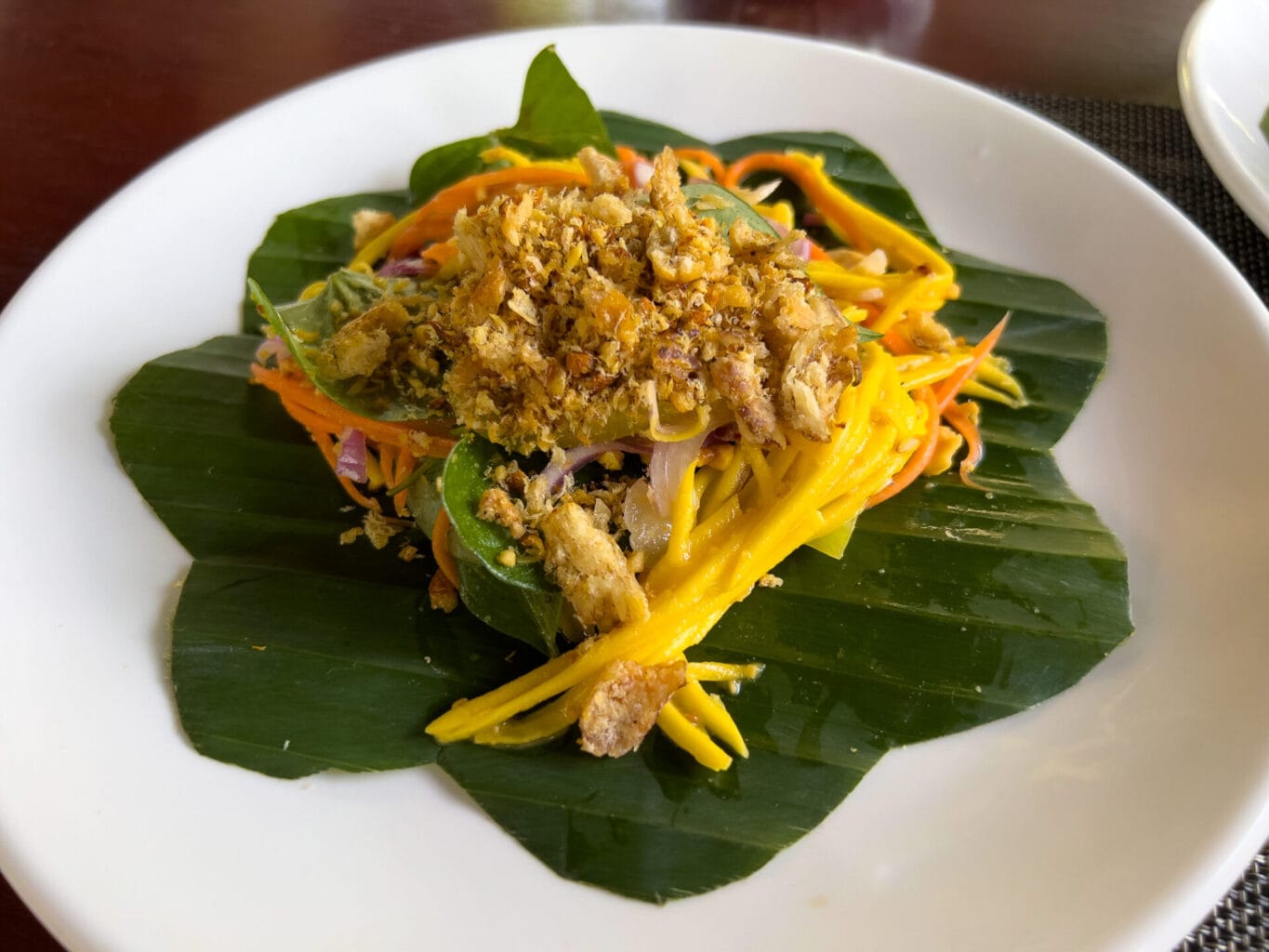
Cooking Khmer Food At A Local’s Home
On our last day in Siem Reap, we traded majestic ruins for something more intimate: food. Not restaurant food, not hotel buffet food…real food. The kind that’s grown under the same sun you’re sweating under, the kind you prepare with your hands, the kind that connects you directly to a place and its people.
We booked a local market tour and cooking class in Siem Reap through Klook once again (Link to that here). It turned out to be the kind of immersive experience that makes you feel like you’re not just visiting a country—you’re living it, even if only for a few hours.
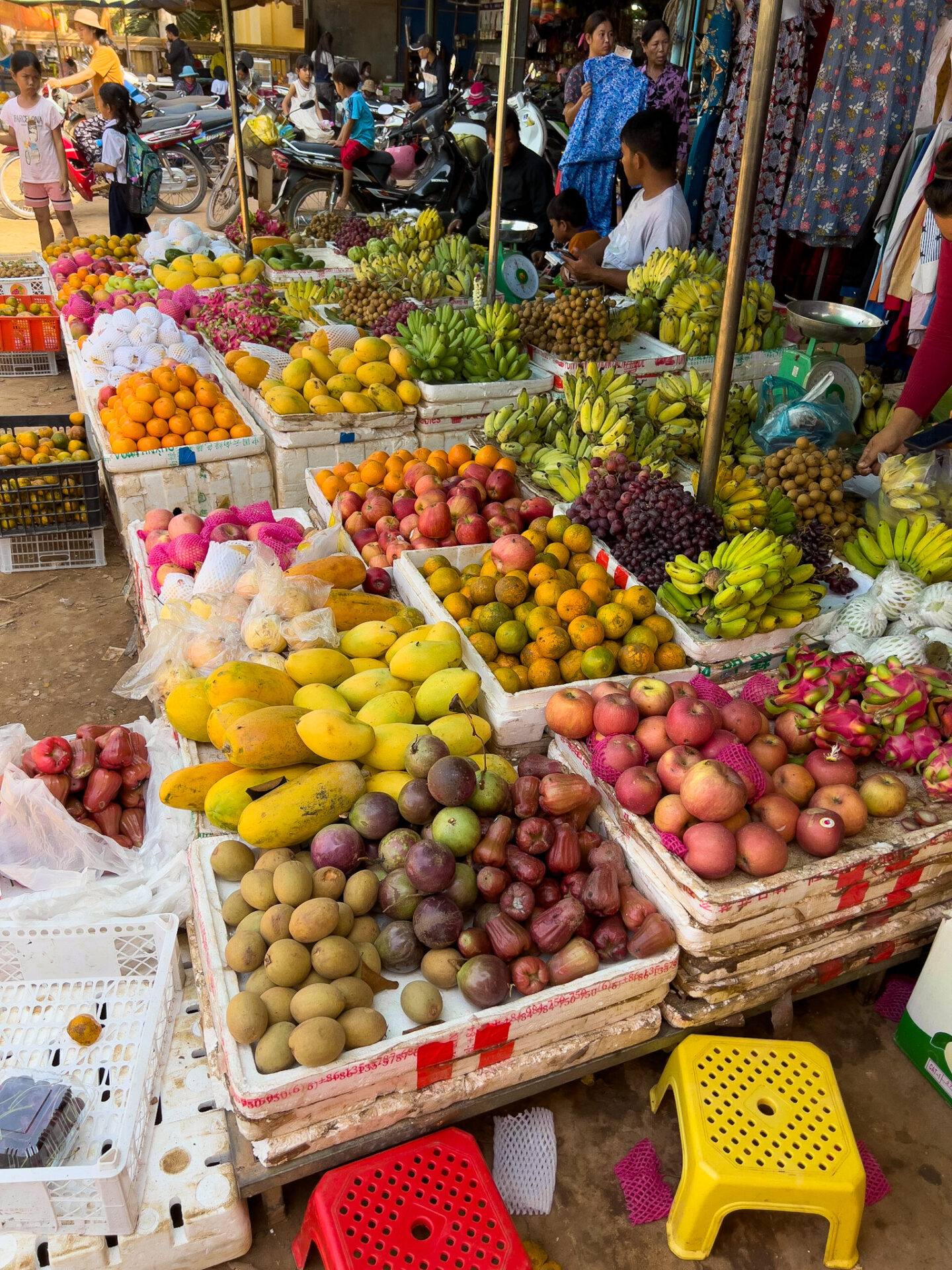
From Market to Meal
The market was rustic, grounded in the flow of daily life in Siem Reap. Vendors lined up inside and along the periphery of the market, some perched behind wooden stalls, others cross-legged on tarps. Mopeds parked casually beside piles of produce. The vibe felt chaotic and vibrant—eggplants next to tamarind, pineapples stacked beside lemongrass, a wide selection of vegetables and tropical fruits.
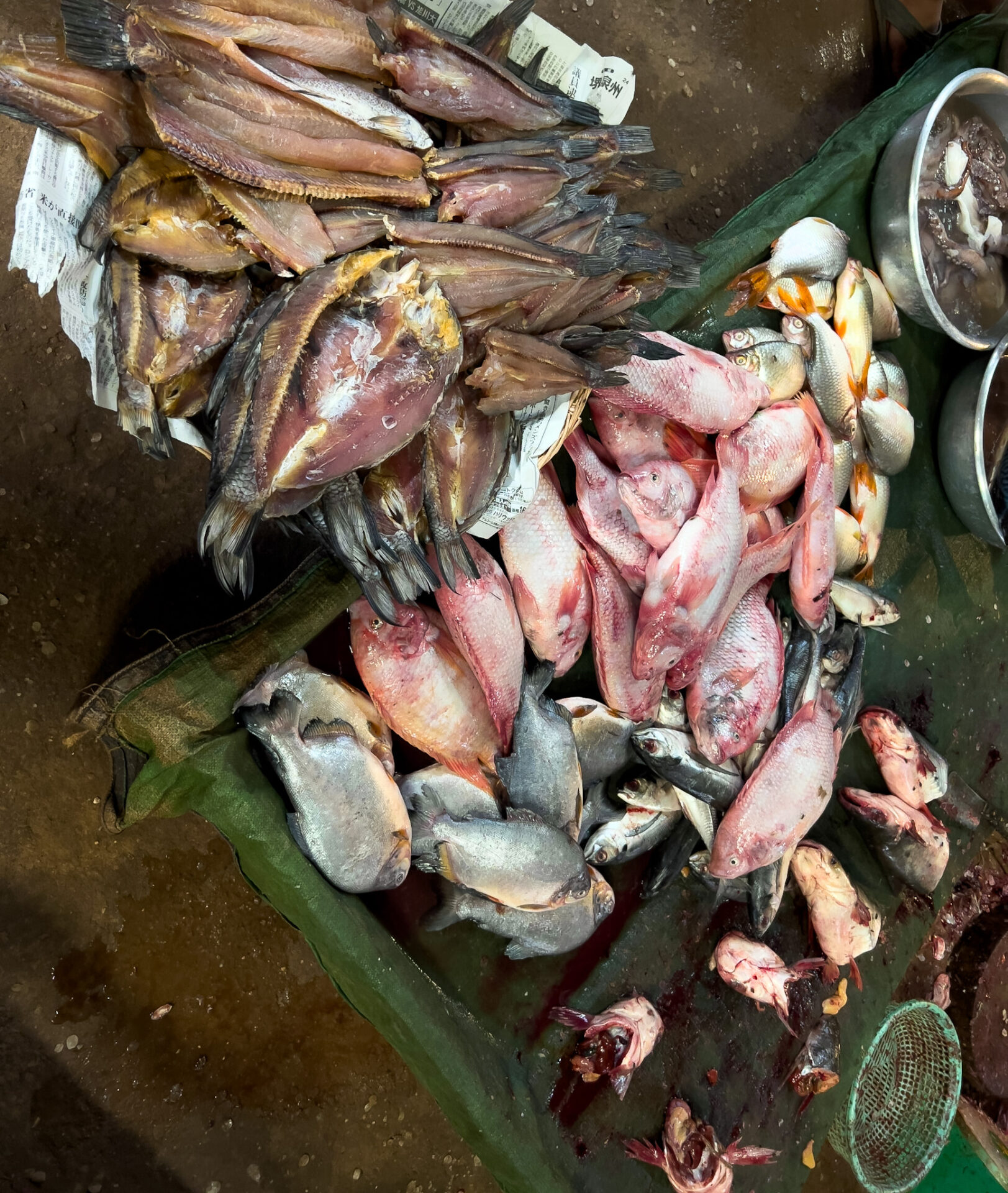
Then there were the proteins: fresh and dried freshwater fish, snails, eels, even coiled snakes. Piles of chickens with jet-black feet. The air was thick with the earthy scent of clay-rich dirt, grilled meat, and ripe mangoes. Once again, it reminded me of the small-town markets in Belize…raw, real, and untamed.
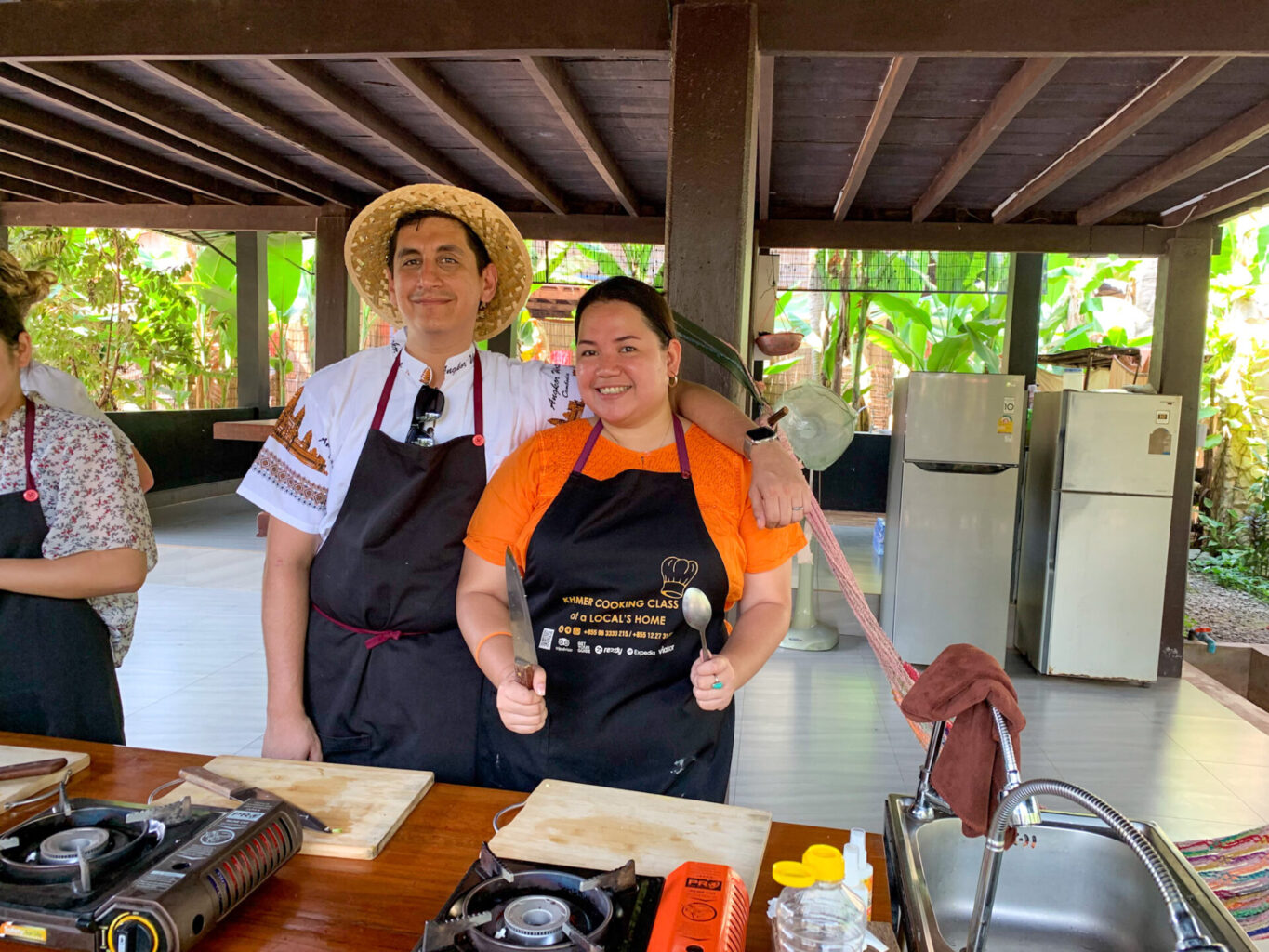
The Outdoor Kitchen Experience
After we finished our ingredient hunting, we rode out to a local’s home where the cooking would begin. Their stilted hardwood house was modest but proper, practical in design, with the kitchen located beneath the house, tiled and open air. The setup had everything: a fridge, prep station, an outdoor grill—the kind of kitchen I’ve always wanted. Cooking outside just feels more human, more elemental. The fire, the smoke, the sun—there’s no faking it.
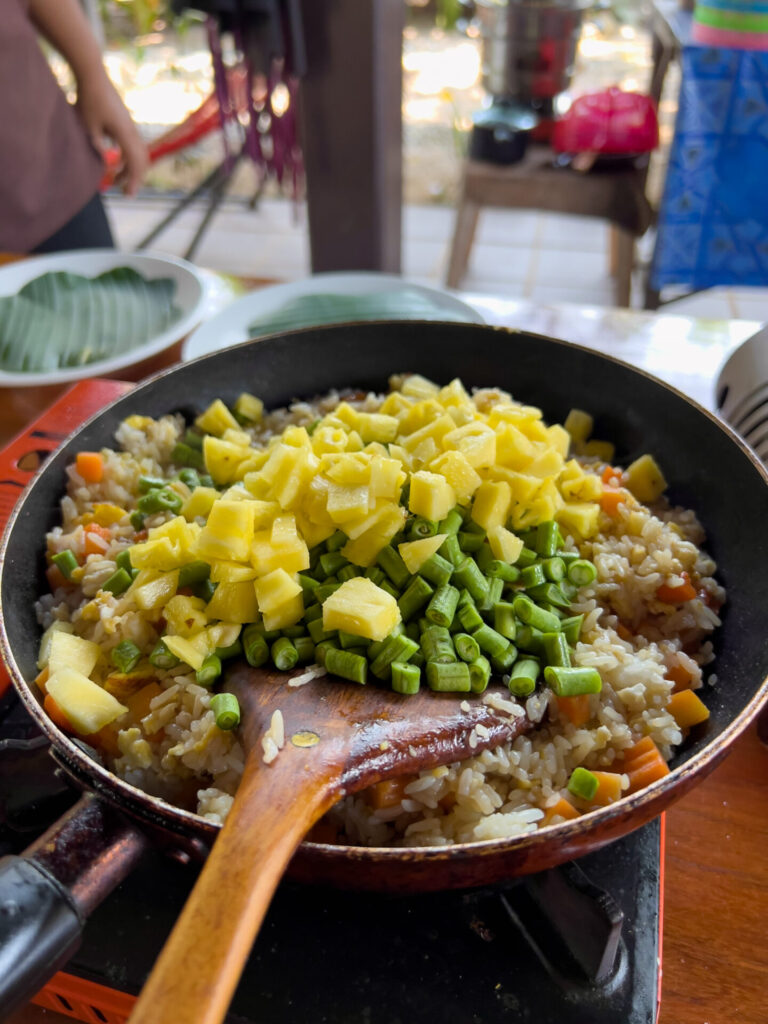
Flavors of Cambodia
We prepped and cooked three dishes: pineapple fried rice, tom yum, and the local-favorite fish amok. The flavors were familiar, yet restrained. Where Thai cuisine might punch you in the throat with chili and funk, Cambodian dishes whisper—subtler, milder, but deeply aromatic.
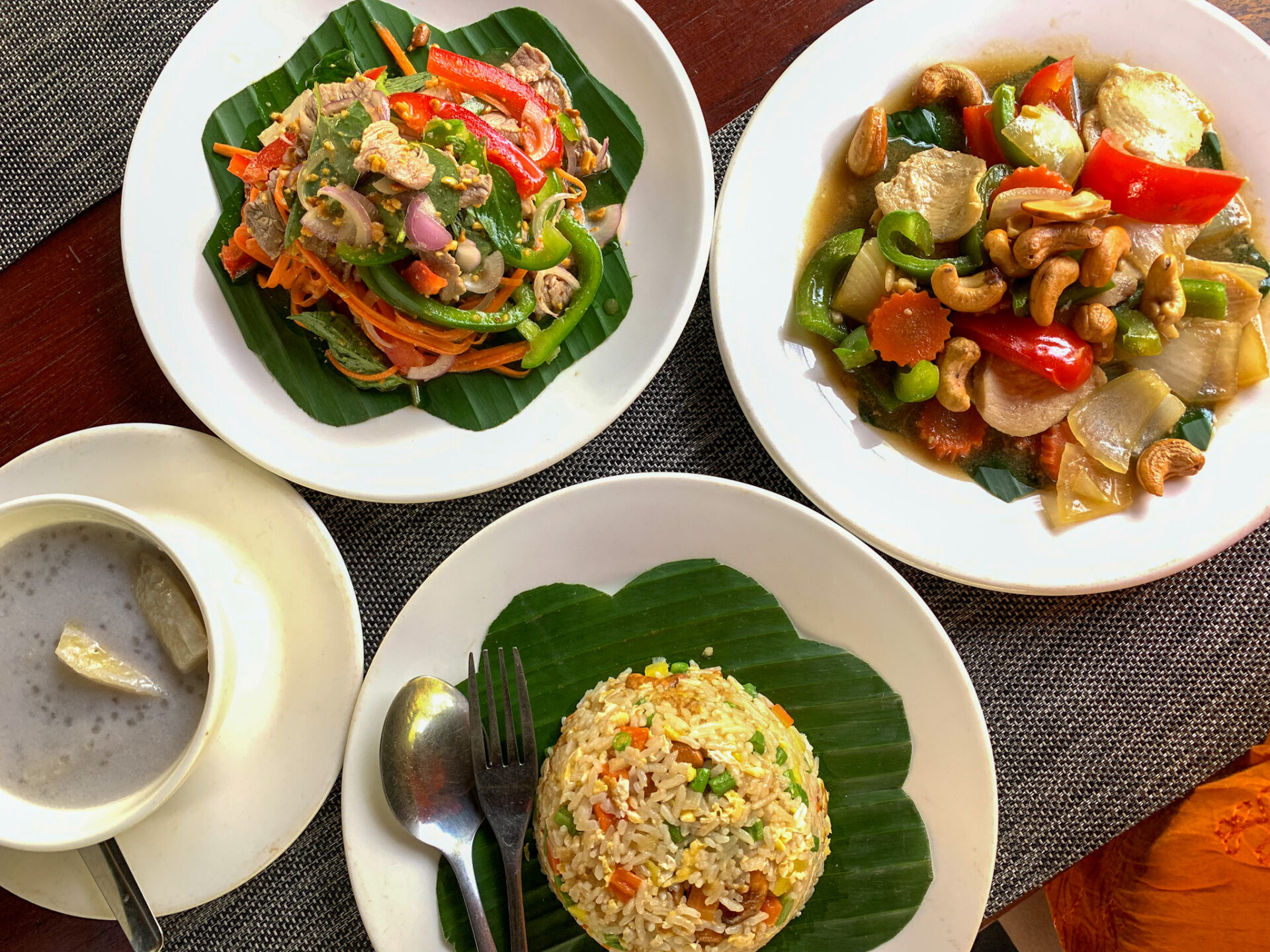
Cooking with Strangers, Eating Like Family
The group was small, maybe ten of us in total. We laughed, coversed, stirred, and chopped together like a makeshift family. For a few hours, we weren’t tourists in Siem Reap; we were cooks. Students of flavor. Guests in someone’s home. It was the perfect way to end our trip. Not with more sightseeing, but by tasting and touching the everyday textures of Cambodian life.

Final Thoughts – Siem Reap Beneath the Surface
Cambodia surprised me—not because it had grand temples, interesting food, or friendly people. I expected all that. But it was the texture of the place that stayed with me. The contrast between sacred temples swallowed by jungle and people laughing beside motorbikes on dusty roads. The way a tuk tuk driver could make you feel more welcome in five minutes than a luxury hotel ever could. The way fish amok, cooked under a local’s stilted home, could feel like the most meaningful meal of the trip.
It’s easy to come to Siem Reap for Angkor Wat. It’s majestic, mysterious, a marvel by any standard. But it’s the moments in between: the unexpected hospitality, the sensory overload of a market, the quiet of a shrine nestled beside someone’s garden—that show you the soul of this country.
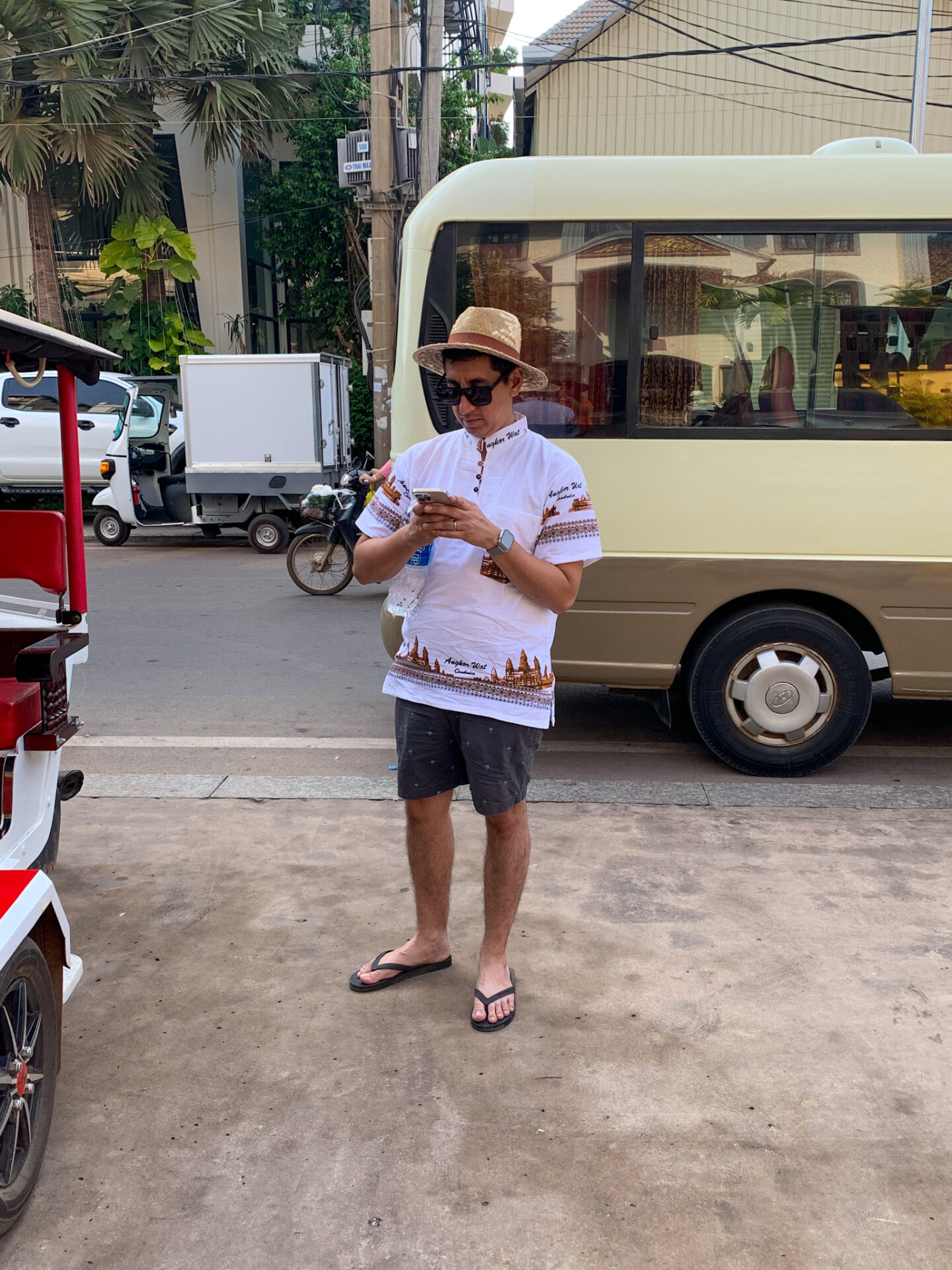
You don’t just visit Cambodia. You absorb it. It seeps into your skin with the midday sweat, it lingers in the scent of grilled meats and incense, it follows you home in paintings and peppercorns.
And long after your departing plane ride ends, you’ll still be thinking about those stone faces, those jungle-wrapped temples, and that perfectly fried egg with kampot pepper.